Healthcare System Assessment
VerifiedAdded on 2022/11/24
|19
|5081
|345
AI Summary
This article provides an analysis of the healthcare systems in Australia and China, comparing their performance, efficiency, and access to healthcare. It includes a framework for assessment and indicators of performance. The assessment is based on the World Health Organization's framework for evaluating health systems. The article highlights the differences in healthcare performance between the two countries and discusses factors that influence the performance of the health systems.
Contribute Materials
Your contribution can guide someone’s learning journey. Share your
documents today.
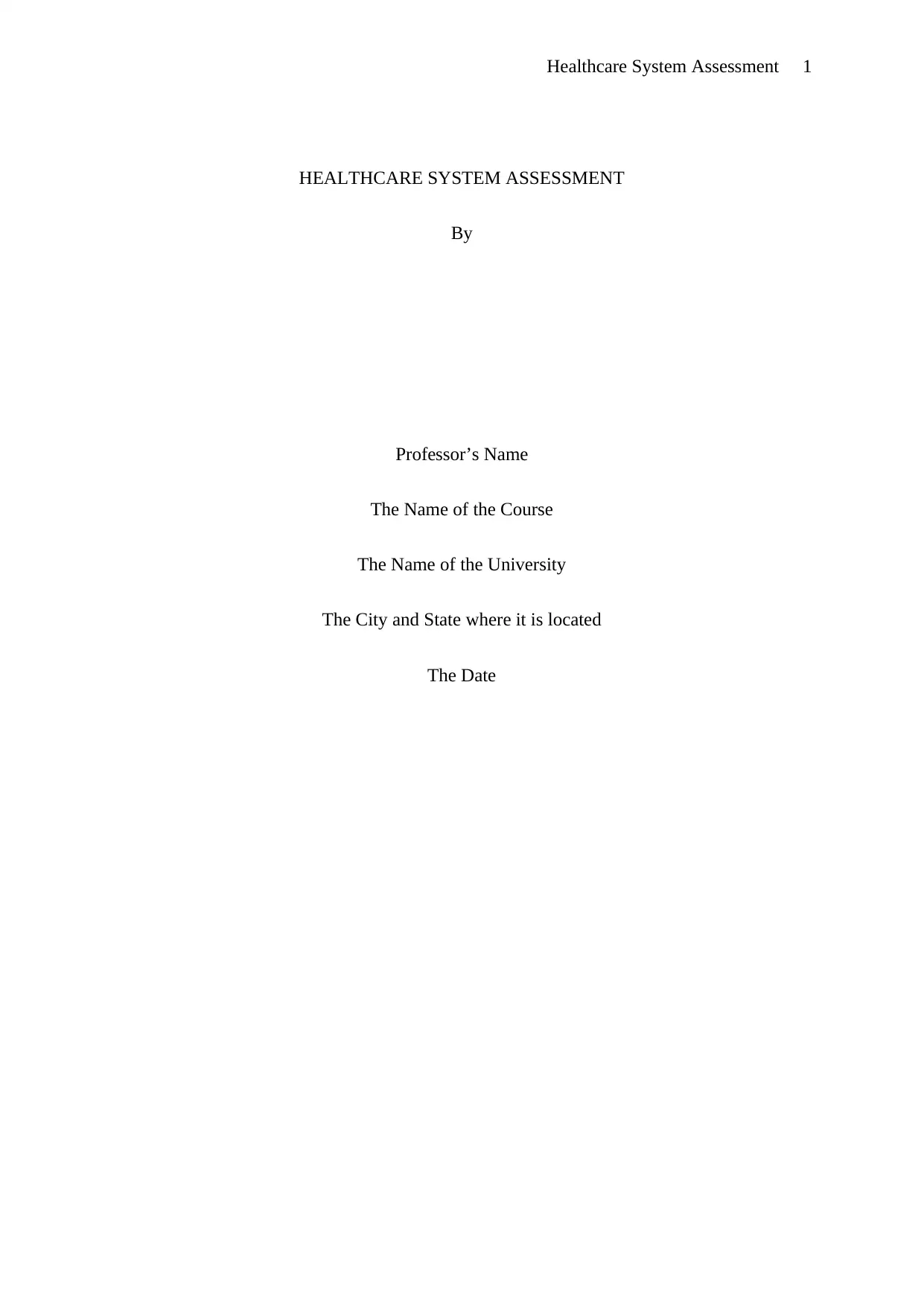
Healthcare System Assessment 1
HEALTHCARE SYSTEM ASSESSMENT
By
Professor’s Name
The Name of the Course
The Name of the University
The City and State where it is located
The Date
HEALTHCARE SYSTEM ASSESSMENT
By
Professor’s Name
The Name of the Course
The Name of the University
The City and State where it is located
The Date
Secure Best Marks with AI Grader
Need help grading? Try our AI Grader for instant feedback on your assignments.
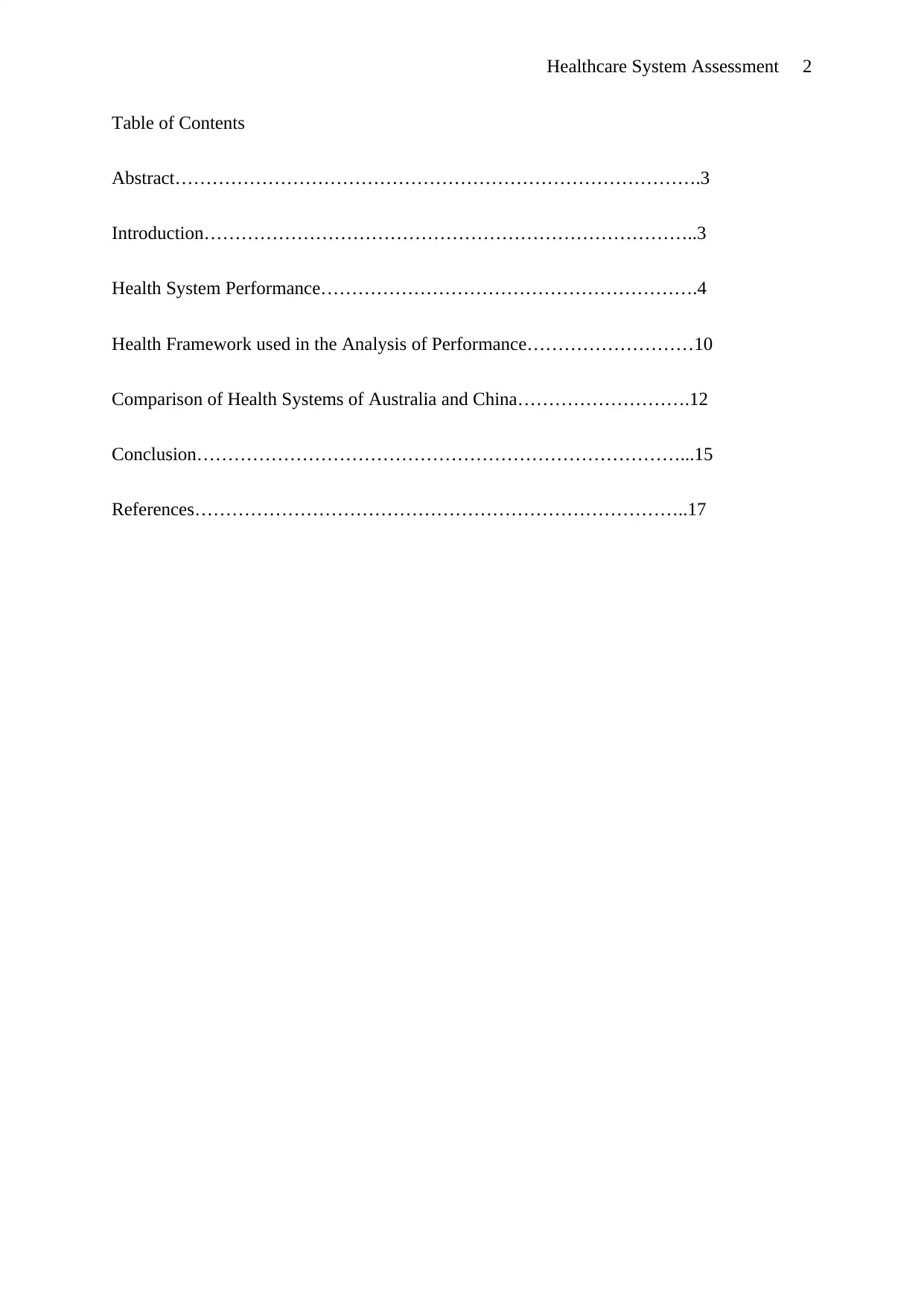
Healthcare System Assessment 2
Table of Contents
Abstract………………………………………………………………………….3
Introduction……………………………………………………………………..3
Health System Performance…………………………………………………….4
Health Framework used in the Analysis of Performance………………………10
Comparison of Health Systems of Australia and China……………………….12
Conclusion……………………………………………………………………...15
References……………………………………………………………………..17
Table of Contents
Abstract………………………………………………………………………….3
Introduction……………………………………………………………………..3
Health System Performance…………………………………………………….4
Health Framework used in the Analysis of Performance………………………10
Comparison of Health Systems of Australia and China……………………….12
Conclusion……………………………………………………………………...15
References……………………………………………………………………..17
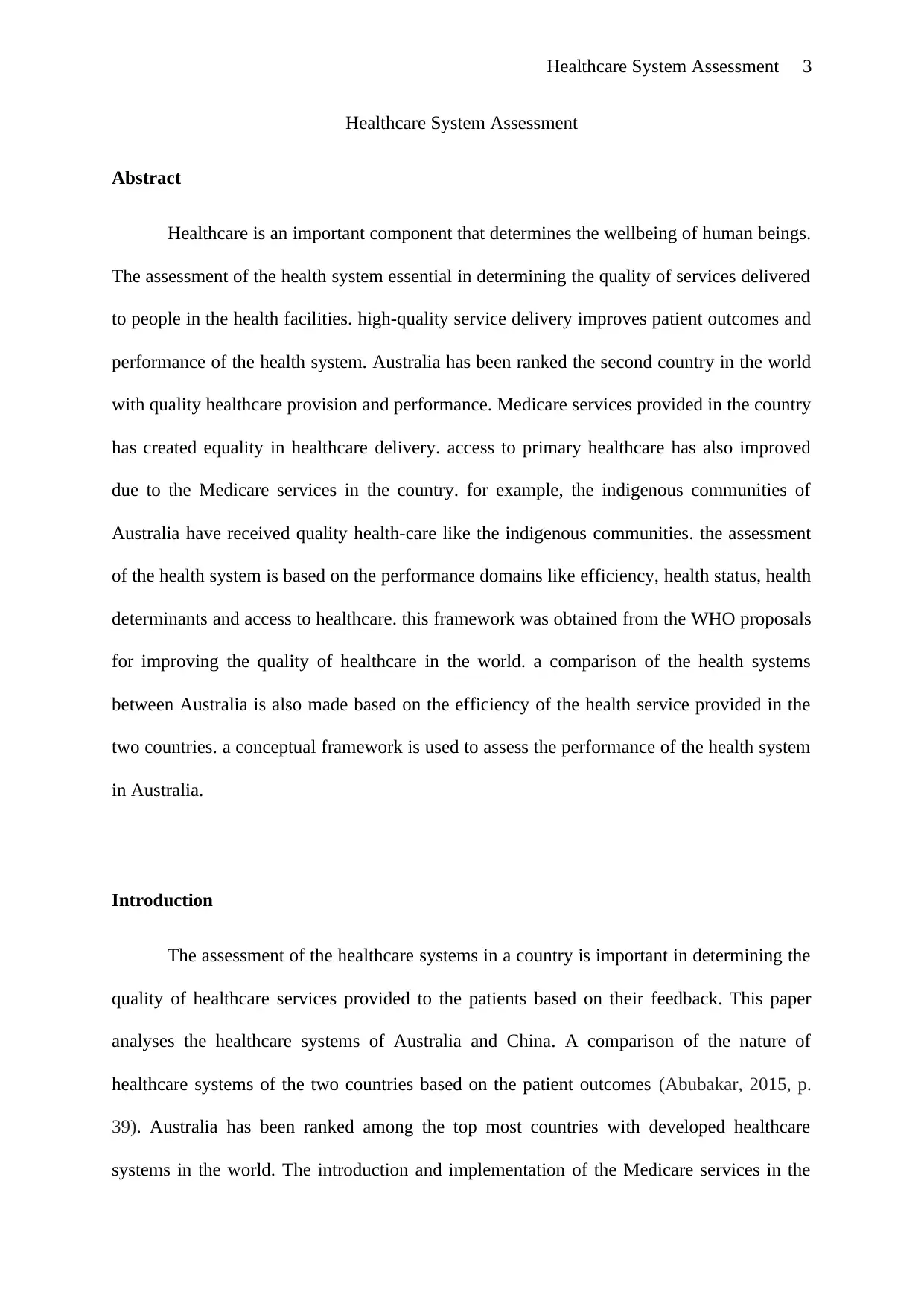
Healthcare System Assessment 3
Healthcare System Assessment
Abstract
Healthcare is an important component that determines the wellbeing of human beings.
The assessment of the health system essential in determining the quality of services delivered
to people in the health facilities. high-quality service delivery improves patient outcomes and
performance of the health system. Australia has been ranked the second country in the world
with quality healthcare provision and performance. Medicare services provided in the country
has created equality in healthcare delivery. access to primary healthcare has also improved
due to the Medicare services in the country. for example, the indigenous communities of
Australia have received quality health-care like the indigenous communities. the assessment
of the health system is based on the performance domains like efficiency, health status, health
determinants and access to healthcare. this framework was obtained from the WHO proposals
for improving the quality of healthcare in the world. a comparison of the health systems
between Australia is also made based on the efficiency of the health service provided in the
two countries. a conceptual framework is used to assess the performance of the health system
in Australia.
Introduction
The assessment of the healthcare systems in a country is important in determining the
quality of healthcare services provided to the patients based on their feedback. This paper
analyses the healthcare systems of Australia and China. A comparison of the nature of
healthcare systems of the two countries based on the patient outcomes (Abubakar, 2015, p.
39). Australia has been ranked among the top most countries with developed healthcare
systems in the world. The introduction and implementation of the Medicare services in the
Healthcare System Assessment
Abstract
Healthcare is an important component that determines the wellbeing of human beings.
The assessment of the health system essential in determining the quality of services delivered
to people in the health facilities. high-quality service delivery improves patient outcomes and
performance of the health system. Australia has been ranked the second country in the world
with quality healthcare provision and performance. Medicare services provided in the country
has created equality in healthcare delivery. access to primary healthcare has also improved
due to the Medicare services in the country. for example, the indigenous communities of
Australia have received quality health-care like the indigenous communities. the assessment
of the health system is based on the performance domains like efficiency, health status, health
determinants and access to healthcare. this framework was obtained from the WHO proposals
for improving the quality of healthcare in the world. a comparison of the health systems
between Australia is also made based on the efficiency of the health service provided in the
two countries. a conceptual framework is used to assess the performance of the health system
in Australia.
Introduction
The assessment of the healthcare systems in a country is important in determining the
quality of healthcare services provided to the patients based on their feedback. This paper
analyses the healthcare systems of Australia and China. A comparison of the nature of
healthcare systems of the two countries based on the patient outcomes (Abubakar, 2015, p.
39). Australia has been ranked among the top most countries with developed healthcare
systems in the world. The introduction and implementation of the Medicare services in the
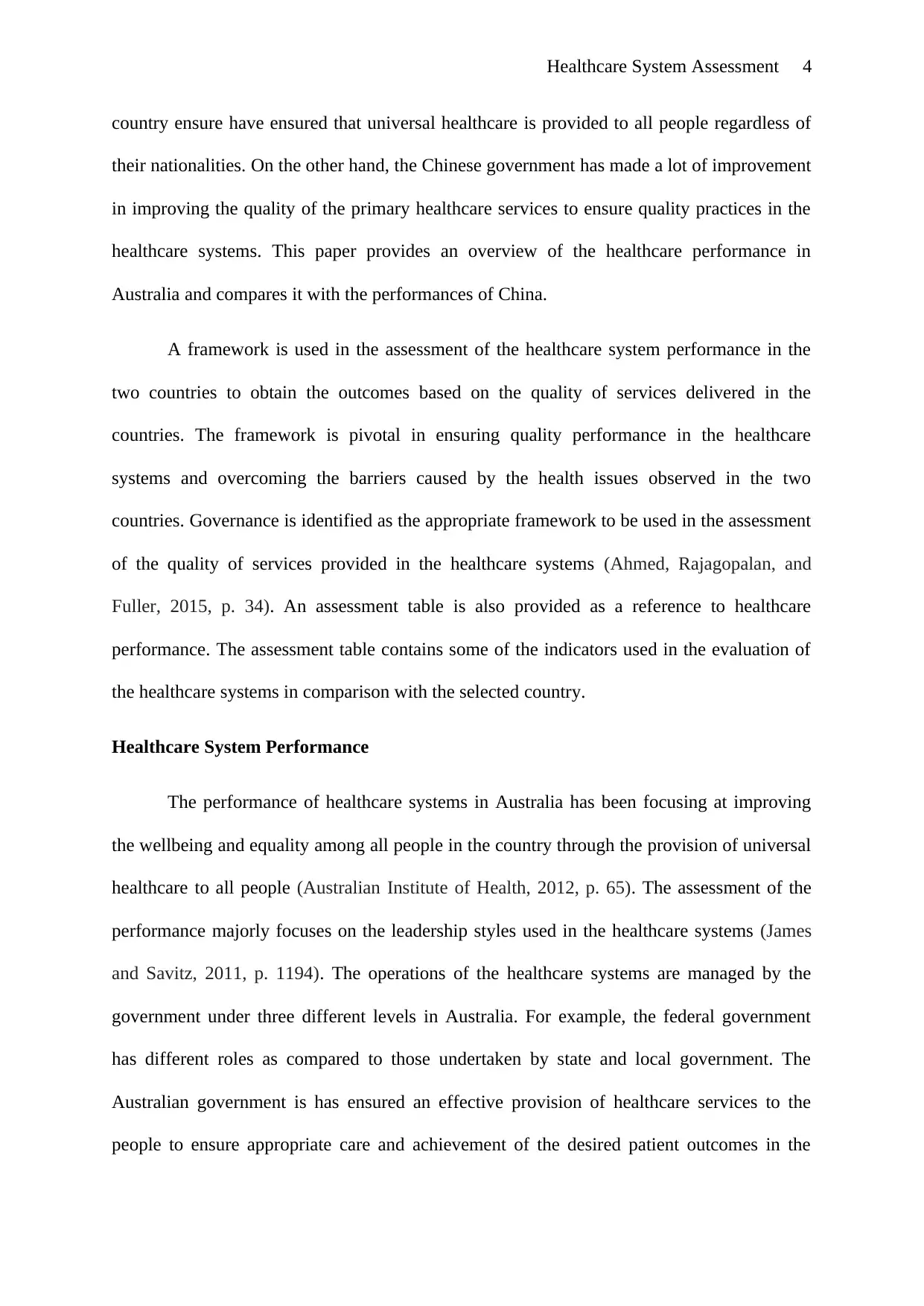
Healthcare System Assessment 4
country ensure have ensured that universal healthcare is provided to all people regardless of
their nationalities. On the other hand, the Chinese government has made a lot of improvement
in improving the quality of the primary healthcare services to ensure quality practices in the
healthcare systems. This paper provides an overview of the healthcare performance in
Australia and compares it with the performances of China.
A framework is used in the assessment of the healthcare system performance in the
two countries to obtain the outcomes based on the quality of services delivered in the
countries. The framework is pivotal in ensuring quality performance in the healthcare
systems and overcoming the barriers caused by the health issues observed in the two
countries. Governance is identified as the appropriate framework to be used in the assessment
of the quality of services provided in the healthcare systems (Ahmed, Rajagopalan, and
Fuller, 2015, p. 34). An assessment table is also provided as a reference to healthcare
performance. The assessment table contains some of the indicators used in the evaluation of
the healthcare systems in comparison with the selected country.
Healthcare System Performance
The performance of healthcare systems in Australia has been focusing at improving
the wellbeing and equality among all people in the country through the provision of universal
healthcare to all people (Australian Institute of Health, 2012, p. 65). The assessment of the
performance majorly focuses on the leadership styles used in the healthcare systems (James
and Savitz, 2011, p. 1194). The operations of the healthcare systems are managed by the
government under three different levels in Australia. For example, the federal government
has different roles as compared to those undertaken by state and local government. The
Australian government is has ensured an effective provision of healthcare services to the
people to ensure appropriate care and achievement of the desired patient outcomes in the
country ensure have ensured that universal healthcare is provided to all people regardless of
their nationalities. On the other hand, the Chinese government has made a lot of improvement
in improving the quality of the primary healthcare services to ensure quality practices in the
healthcare systems. This paper provides an overview of the healthcare performance in
Australia and compares it with the performances of China.
A framework is used in the assessment of the healthcare system performance in the
two countries to obtain the outcomes based on the quality of services delivered in the
countries. The framework is pivotal in ensuring quality performance in the healthcare
systems and overcoming the barriers caused by the health issues observed in the two
countries. Governance is identified as the appropriate framework to be used in the assessment
of the quality of services provided in the healthcare systems (Ahmed, Rajagopalan, and
Fuller, 2015, p. 34). An assessment table is also provided as a reference to healthcare
performance. The assessment table contains some of the indicators used in the evaluation of
the healthcare systems in comparison with the selected country.
Healthcare System Performance
The performance of healthcare systems in Australia has been focusing at improving
the wellbeing and equality among all people in the country through the provision of universal
healthcare to all people (Australian Institute of Health, 2012, p. 65). The assessment of the
performance majorly focuses on the leadership styles used in the healthcare systems (James
and Savitz, 2011, p. 1194). The operations of the healthcare systems are managed by the
government under three different levels in Australia. For example, the federal government
has different roles as compared to those undertaken by state and local government. The
Australian government is has ensured an effective provision of healthcare services to the
people to ensure appropriate care and achievement of the desired patient outcomes in the
Secure Best Marks with AI Grader
Need help grading? Try our AI Grader for instant feedback on your assignments.
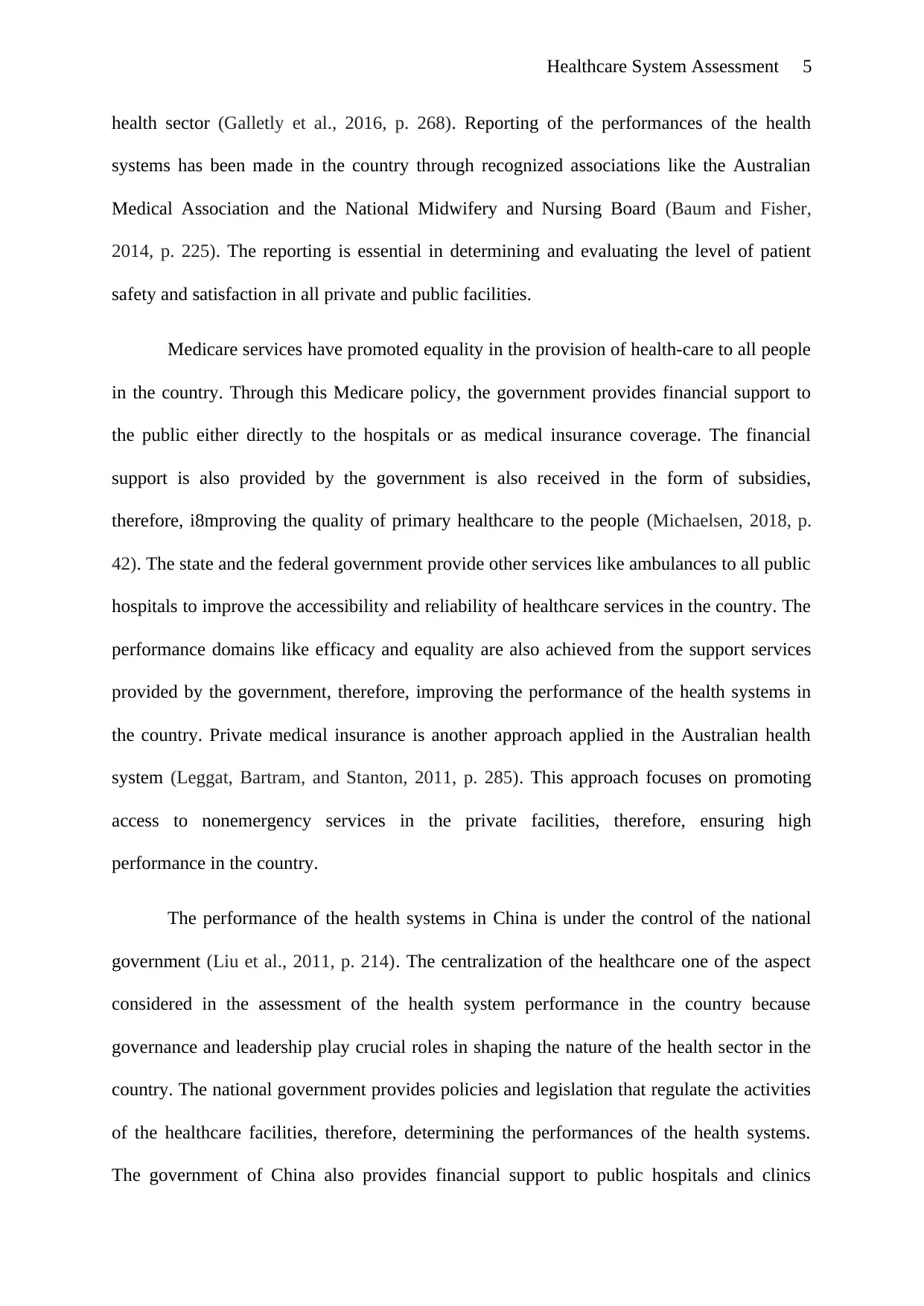
Healthcare System Assessment 5
health sector (Galletly et al., 2016, p. 268). Reporting of the performances of the health
systems has been made in the country through recognized associations like the Australian
Medical Association and the National Midwifery and Nursing Board (Baum and Fisher,
2014, p. 225). The reporting is essential in determining and evaluating the level of patient
safety and satisfaction in all private and public facilities.
Medicare services have promoted equality in the provision of health-care to all people
in the country. Through this Medicare policy, the government provides financial support to
the public either directly to the hospitals or as medical insurance coverage. The financial
support is also provided by the government is also received in the form of subsidies,
therefore, i8mproving the quality of primary healthcare to the people (Michaelsen, 2018, p.
42). The state and the federal government provide other services like ambulances to all public
hospitals to improve the accessibility and reliability of healthcare services in the country. The
performance domains like efficacy and equality are also achieved from the support services
provided by the government, therefore, improving the performance of the health systems in
the country. Private medical insurance is another approach applied in the Australian health
system (Leggat, Bartram, and Stanton, 2011, p. 285). This approach focuses on promoting
access to nonemergency services in the private facilities, therefore, ensuring high
performance in the country.
The performance of the health systems in China is under the control of the national
government (Liu et al., 2011, p. 214). The centralization of the healthcare one of the aspect
considered in the assessment of the health system performance in the country because
governance and leadership play crucial roles in shaping the nature of the health sector in the
country. The national government provides policies and legislation that regulate the activities
of the healthcare facilities, therefore, determining the performances of the health systems.
The government of China also provides financial support to public hospitals and clinics
health sector (Galletly et al., 2016, p. 268). Reporting of the performances of the health
systems has been made in the country through recognized associations like the Australian
Medical Association and the National Midwifery and Nursing Board (Baum and Fisher,
2014, p. 225). The reporting is essential in determining and evaluating the level of patient
safety and satisfaction in all private and public facilities.
Medicare services have promoted equality in the provision of health-care to all people
in the country. Through this Medicare policy, the government provides financial support to
the public either directly to the hospitals or as medical insurance coverage. The financial
support is also provided by the government is also received in the form of subsidies,
therefore, i8mproving the quality of primary healthcare to the people (Michaelsen, 2018, p.
42). The state and the federal government provide other services like ambulances to all public
hospitals to improve the accessibility and reliability of healthcare services in the country. The
performance domains like efficacy and equality are also achieved from the support services
provided by the government, therefore, improving the performance of the health systems in
the country. Private medical insurance is another approach applied in the Australian health
system (Leggat, Bartram, and Stanton, 2011, p. 285). This approach focuses on promoting
access to nonemergency services in the private facilities, therefore, ensuring high
performance in the country.
The performance of the health systems in China is under the control of the national
government (Liu et al., 2011, p. 214). The centralization of the healthcare one of the aspect
considered in the assessment of the health system performance in the country because
governance and leadership play crucial roles in shaping the nature of the health sector in the
country. The national government provides policies and legislation that regulate the activities
of the healthcare facilities, therefore, determining the performances of the health systems.
The government of China also provides financial support to public hospitals and clinics
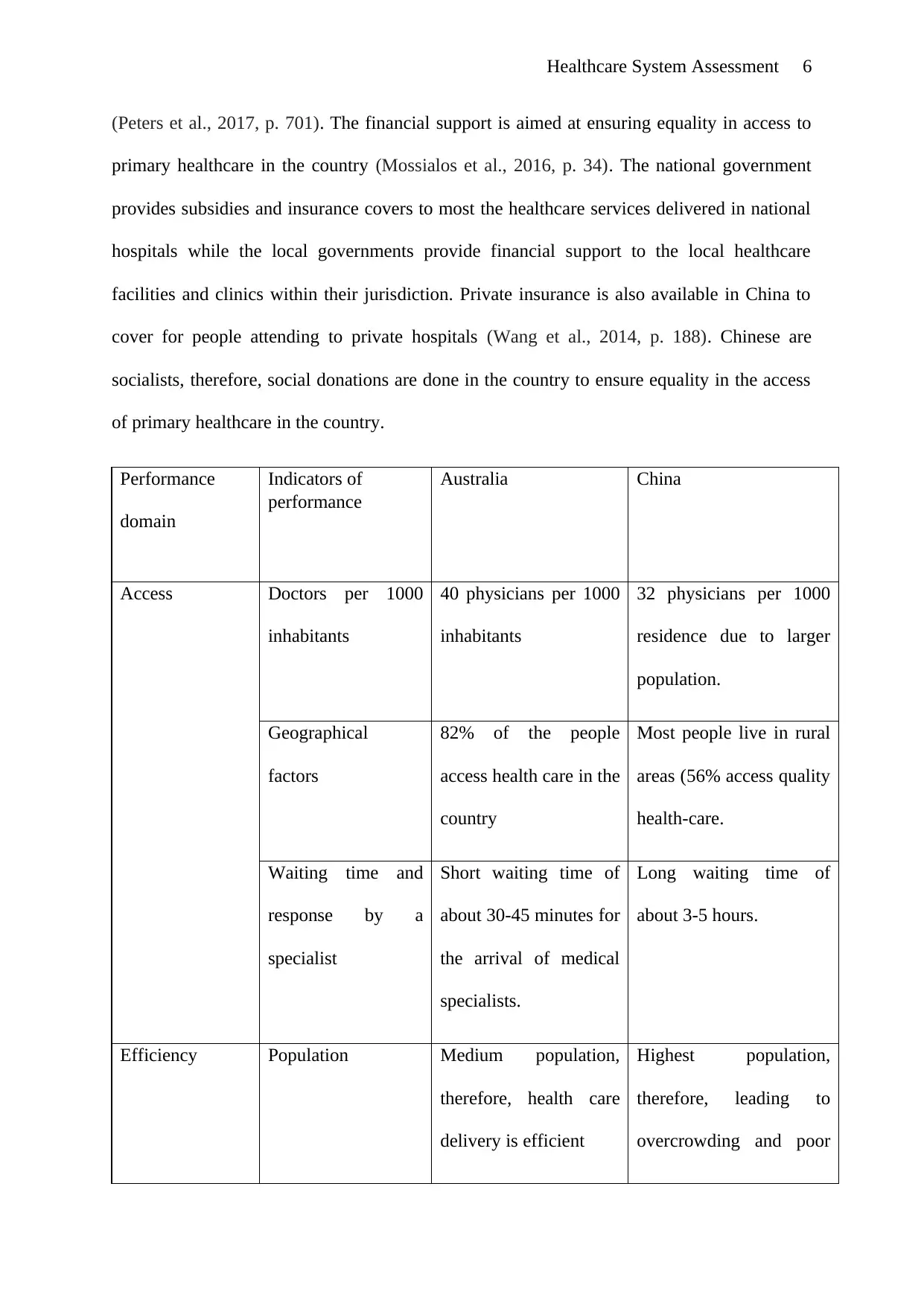
Healthcare System Assessment 6
(Peters et al., 2017, p. 701). The financial support is aimed at ensuring equality in access to
primary healthcare in the country (Mossialos et al., 2016, p. 34). The national government
provides subsidies and insurance covers to most the healthcare services delivered in national
hospitals while the local governments provide financial support to the local healthcare
facilities and clinics within their jurisdiction. Private insurance is also available in China to
cover for people attending to private hospitals (Wang et al., 2014, p. 188). Chinese are
socialists, therefore, social donations are done in the country to ensure equality in the access
of primary healthcare in the country.
Performance
domain
Indicators of
performance
Australia China
Access Doctors per 1000
inhabitants
40 physicians per 1000
inhabitants
32 physicians per 1000
residence due to larger
population.
Geographical
factors
82% of the people
access health care in the
country
Most people live in rural
areas (56% access quality
health-care.
Waiting time and
response by a
specialist
Short waiting time of
about 30-45 minutes for
the arrival of medical
specialists.
Long waiting time of
about 3-5 hours.
Efficiency Population Medium population,
therefore, health care
delivery is efficient
Highest population,
therefore, leading to
overcrowding and poor
(Peters et al., 2017, p. 701). The financial support is aimed at ensuring equality in access to
primary healthcare in the country (Mossialos et al., 2016, p. 34). The national government
provides subsidies and insurance covers to most the healthcare services delivered in national
hospitals while the local governments provide financial support to the local healthcare
facilities and clinics within their jurisdiction. Private insurance is also available in China to
cover for people attending to private hospitals (Wang et al., 2014, p. 188). Chinese are
socialists, therefore, social donations are done in the country to ensure equality in the access
of primary healthcare in the country.
Performance
domain
Indicators of
performance
Australia China
Access Doctors per 1000
inhabitants
40 physicians per 1000
inhabitants
32 physicians per 1000
residence due to larger
population.
Geographical
factors
82% of the people
access health care in the
country
Most people live in rural
areas (56% access quality
health-care.
Waiting time and
response by a
specialist
Short waiting time of
about 30-45 minutes for
the arrival of medical
specialists.
Long waiting time of
about 3-5 hours.
Efficiency Population Medium population,
therefore, health care
delivery is efficient
Highest population,
therefore, leading to
overcrowding and poor
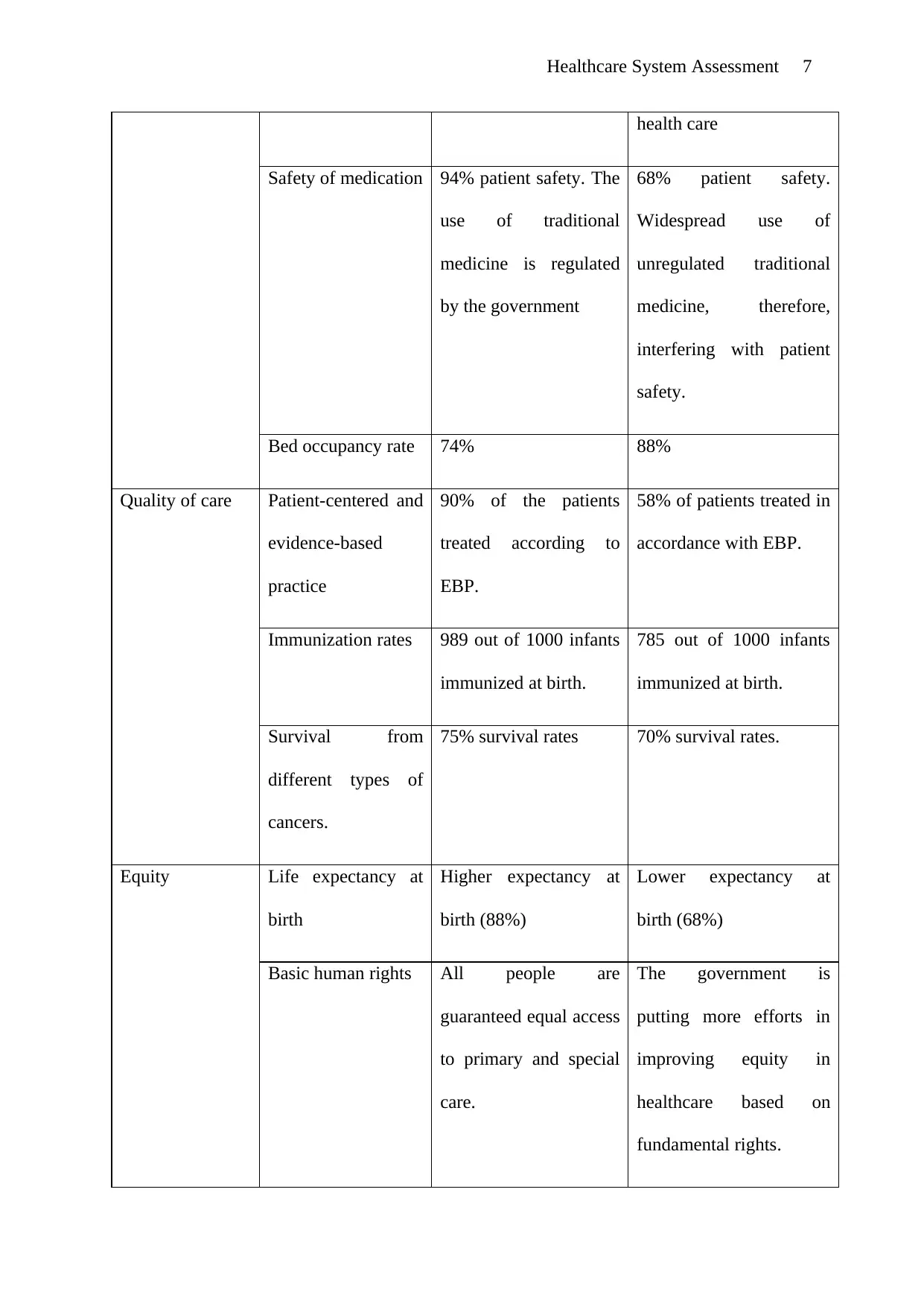
Healthcare System Assessment 7
health care
Safety of medication 94% patient safety. The
use of traditional
medicine is regulated
by the government
68% patient safety.
Widespread use of
unregulated traditional
medicine, therefore,
interfering with patient
safety.
Bed occupancy rate 74% 88%
Quality of care Patient-centered and
evidence-based
practice
90% of the patients
treated according to
EBP.
58% of patients treated in
accordance with EBP.
Immunization rates 989 out of 1000 infants
immunized at birth.
785 out of 1000 infants
immunized at birth.
Survival from
different types of
cancers.
75% survival rates 70% survival rates.
Equity Life expectancy at
birth
Higher expectancy at
birth (88%)
Lower expectancy at
birth (68%)
Basic human rights All people are
guaranteed equal access
to primary and special
care.
The government is
putting more efforts in
improving equity in
healthcare based on
fundamental rights.
health care
Safety of medication 94% patient safety. The
use of traditional
medicine is regulated
by the government
68% patient safety.
Widespread use of
unregulated traditional
medicine, therefore,
interfering with patient
safety.
Bed occupancy rate 74% 88%
Quality of care Patient-centered and
evidence-based
practice
90% of the patients
treated according to
EBP.
58% of patients treated in
accordance with EBP.
Immunization rates 989 out of 1000 infants
immunized at birth.
785 out of 1000 infants
immunized at birth.
Survival from
different types of
cancers.
75% survival rates 70% survival rates.
Equity Life expectancy at
birth
Higher expectancy at
birth (88%)
Lower expectancy at
birth (68%)
Basic human rights All people are
guaranteed equal access
to primary and special
care.
The government is
putting more efforts in
improving equity in
healthcare based on
fundamental rights.
Paraphrase This Document
Need a fresh take? Get an instant paraphrase of this document with our AI Paraphraser
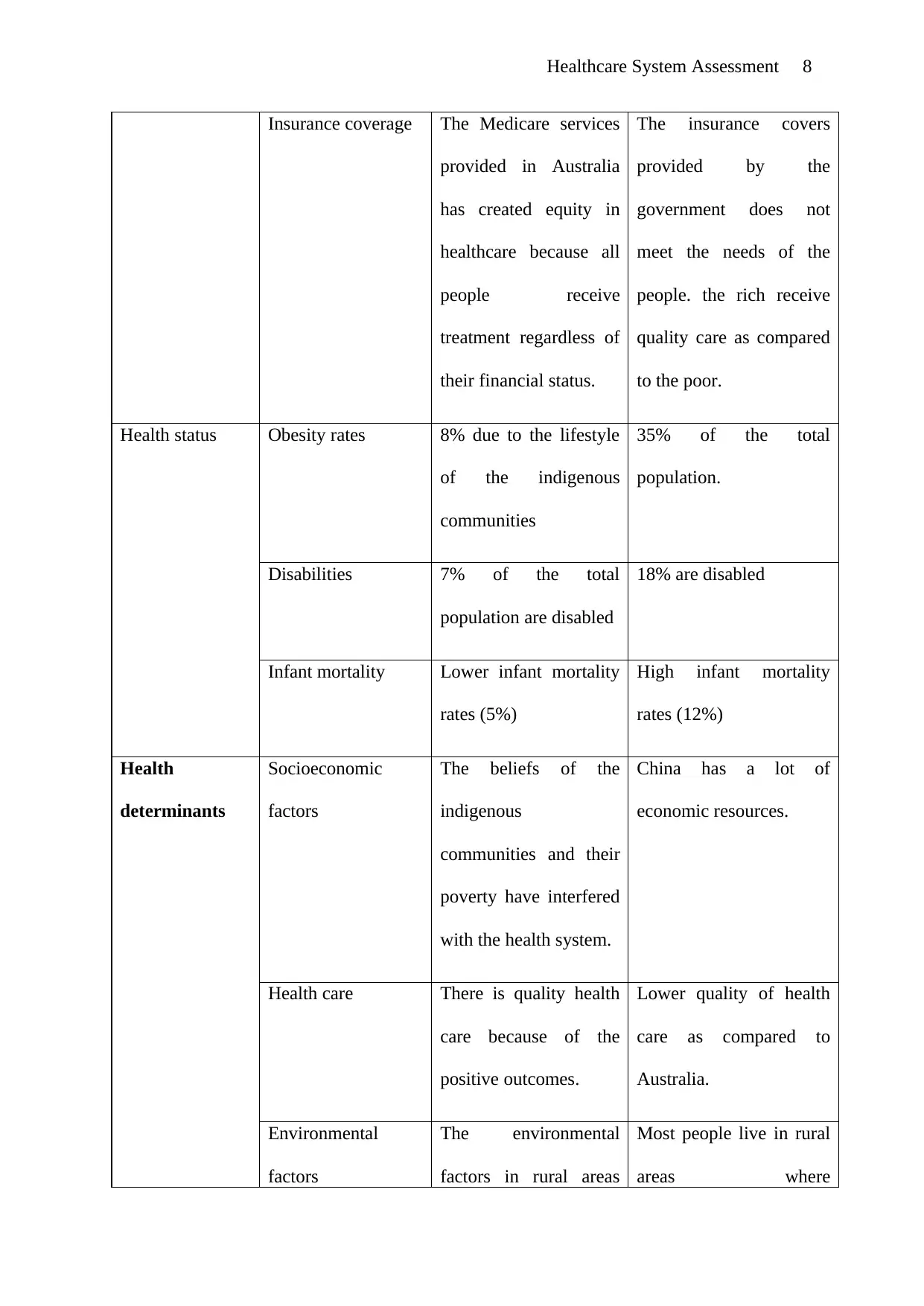
Healthcare System Assessment 8
Insurance coverage The Medicare services
provided in Australia
has created equity in
healthcare because all
people receive
treatment regardless of
their financial status.
The insurance covers
provided by the
government does not
meet the needs of the
people. the rich receive
quality care as compared
to the poor.
Health status Obesity rates 8% due to the lifestyle
of the indigenous
communities
35% of the total
population.
Disabilities 7% of the total
population are disabled
18% are disabled
Infant mortality Lower infant mortality
rates (5%)
High infant mortality
rates (12%)
Health
determinants
Socioeconomic
factors
The beliefs of the
indigenous
communities and their
poverty have interfered
with the health system.
China has a lot of
economic resources.
Health care There is quality health
care because of the
positive outcomes.
Lower quality of health
care as compared to
Australia.
Environmental
factors
The environmental
factors in rural areas
Most people live in rural
areas where
Insurance coverage The Medicare services
provided in Australia
has created equity in
healthcare because all
people receive
treatment regardless of
their financial status.
The insurance covers
provided by the
government does not
meet the needs of the
people. the rich receive
quality care as compared
to the poor.
Health status Obesity rates 8% due to the lifestyle
of the indigenous
communities
35% of the total
population.
Disabilities 7% of the total
population are disabled
18% are disabled
Infant mortality Lower infant mortality
rates (5%)
High infant mortality
rates (12%)
Health
determinants
Socioeconomic
factors
The beliefs of the
indigenous
communities and their
poverty have interfered
with the health system.
China has a lot of
economic resources.
Health care There is quality health
care because of the
positive outcomes.
Lower quality of health
care as compared to
Australia.
Environmental
factors
The environmental
factors in rural areas
Most people live in rural
areas where
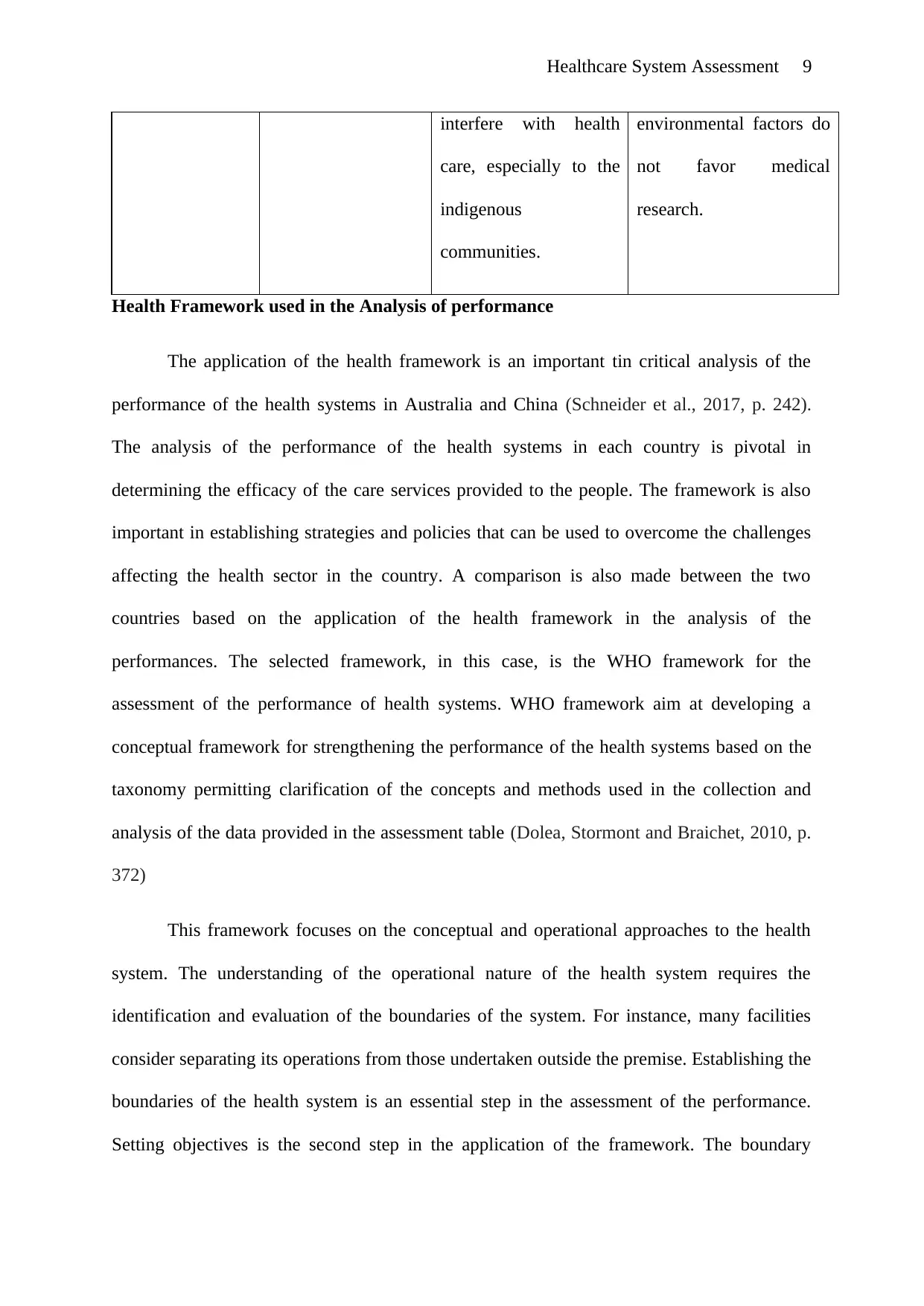
Healthcare System Assessment 9
interfere with health
care, especially to the
indigenous
communities.
environmental factors do
not favor medical
research.
Health Framework used in the Analysis of performance
The application of the health framework is an important tin critical analysis of the
performance of the health systems in Australia and China (Schneider et al., 2017, p. 242).
The analysis of the performance of the health systems in each country is pivotal in
determining the efficacy of the care services provided to the people. The framework is also
important in establishing strategies and policies that can be used to overcome the challenges
affecting the health sector in the country. A comparison is also made between the two
countries based on the application of the health framework in the analysis of the
performances. The selected framework, in this case, is the WHO framework for the
assessment of the performance of health systems. WHO framework aim at developing a
conceptual framework for strengthening the performance of the health systems based on the
taxonomy permitting clarification of the concepts and methods used in the collection and
analysis of the data provided in the assessment table (Dolea, Stormont and Braichet, 2010, p.
372)
This framework focuses on the conceptual and operational approaches to the health
system. The understanding of the operational nature of the health system requires the
identification and evaluation of the boundaries of the system. For instance, many facilities
consider separating its operations from those undertaken outside the premise. Establishing the
boundaries of the health system is an essential step in the assessment of the performance.
Setting objectives is the second step in the application of the framework. The boundary
interfere with health
care, especially to the
indigenous
communities.
environmental factors do
not favor medical
research.
Health Framework used in the Analysis of performance
The application of the health framework is an important tin critical analysis of the
performance of the health systems in Australia and China (Schneider et al., 2017, p. 242).
The analysis of the performance of the health systems in each country is pivotal in
determining the efficacy of the care services provided to the people. The framework is also
important in establishing strategies and policies that can be used to overcome the challenges
affecting the health sector in the country. A comparison is also made between the two
countries based on the application of the health framework in the analysis of the
performances. The selected framework, in this case, is the WHO framework for the
assessment of the performance of health systems. WHO framework aim at developing a
conceptual framework for strengthening the performance of the health systems based on the
taxonomy permitting clarification of the concepts and methods used in the collection and
analysis of the data provided in the assessment table (Dolea, Stormont and Braichet, 2010, p.
372)
This framework focuses on the conceptual and operational approaches to the health
system. The understanding of the operational nature of the health system requires the
identification and evaluation of the boundaries of the system. For instance, many facilities
consider separating its operations from those undertaken outside the premise. Establishing the
boundaries of the health system is an essential step in the assessment of the performance.
Setting objectives is the second step in the application of the framework. The boundary
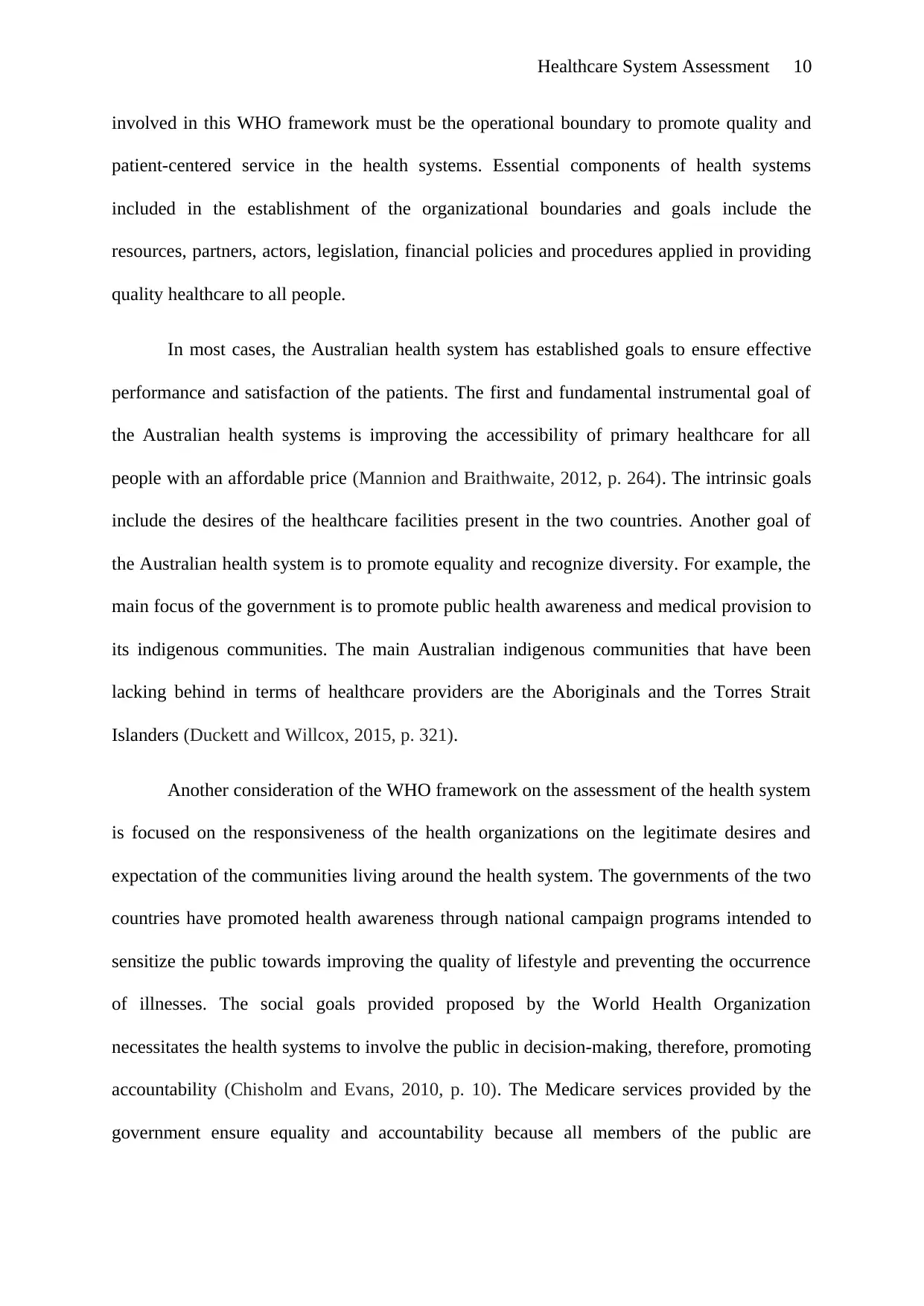
Healthcare System Assessment 10
involved in this WHO framework must be the operational boundary to promote quality and
patient-centered service in the health systems. Essential components of health systems
included in the establishment of the organizational boundaries and goals include the
resources, partners, actors, legislation, financial policies and procedures applied in providing
quality healthcare to all people.
In most cases, the Australian health system has established goals to ensure effective
performance and satisfaction of the patients. The first and fundamental instrumental goal of
the Australian health systems is improving the accessibility of primary healthcare for all
people with an affordable price (Mannion and Braithwaite, 2012, p. 264). The intrinsic goals
include the desires of the healthcare facilities present in the two countries. Another goal of
the Australian health system is to promote equality and recognize diversity. For example, the
main focus of the government is to promote public health awareness and medical provision to
its indigenous communities. The main Australian indigenous communities that have been
lacking behind in terms of healthcare providers are the Aboriginals and the Torres Strait
Islanders (Duckett and Willcox, 2015, p. 321).
Another consideration of the WHO framework on the assessment of the health system
is focused on the responsiveness of the health organizations on the legitimate desires and
expectation of the communities living around the health system. The governments of the two
countries have promoted health awareness through national campaign programs intended to
sensitize the public towards improving the quality of lifestyle and preventing the occurrence
of illnesses. The social goals provided proposed by the World Health Organization
necessitates the health systems to involve the public in decision-making, therefore, promoting
accountability (Chisholm and Evans, 2010, p. 10). The Medicare services provided by the
government ensure equality and accountability because all members of the public are
involved in this WHO framework must be the operational boundary to promote quality and
patient-centered service in the health systems. Essential components of health systems
included in the establishment of the organizational boundaries and goals include the
resources, partners, actors, legislation, financial policies and procedures applied in providing
quality healthcare to all people.
In most cases, the Australian health system has established goals to ensure effective
performance and satisfaction of the patients. The first and fundamental instrumental goal of
the Australian health systems is improving the accessibility of primary healthcare for all
people with an affordable price (Mannion and Braithwaite, 2012, p. 264). The intrinsic goals
include the desires of the healthcare facilities present in the two countries. Another goal of
the Australian health system is to promote equality and recognize diversity. For example, the
main focus of the government is to promote public health awareness and medical provision to
its indigenous communities. The main Australian indigenous communities that have been
lacking behind in terms of healthcare providers are the Aboriginals and the Torres Strait
Islanders (Duckett and Willcox, 2015, p. 321).
Another consideration of the WHO framework on the assessment of the health system
is focused on the responsiveness of the health organizations on the legitimate desires and
expectation of the communities living around the health system. The governments of the two
countries have promoted health awareness through national campaign programs intended to
sensitize the public towards improving the quality of lifestyle and preventing the occurrence
of illnesses. The social goals provided proposed by the World Health Organization
necessitates the health systems to involve the public in decision-making, therefore, promoting
accountability (Chisholm and Evans, 2010, p. 10). The Medicare services provided by the
government ensure equality and accountability because all members of the public are
Secure Best Marks with AI Grader
Need help grading? Try our AI Grader for instant feedback on your assignments.
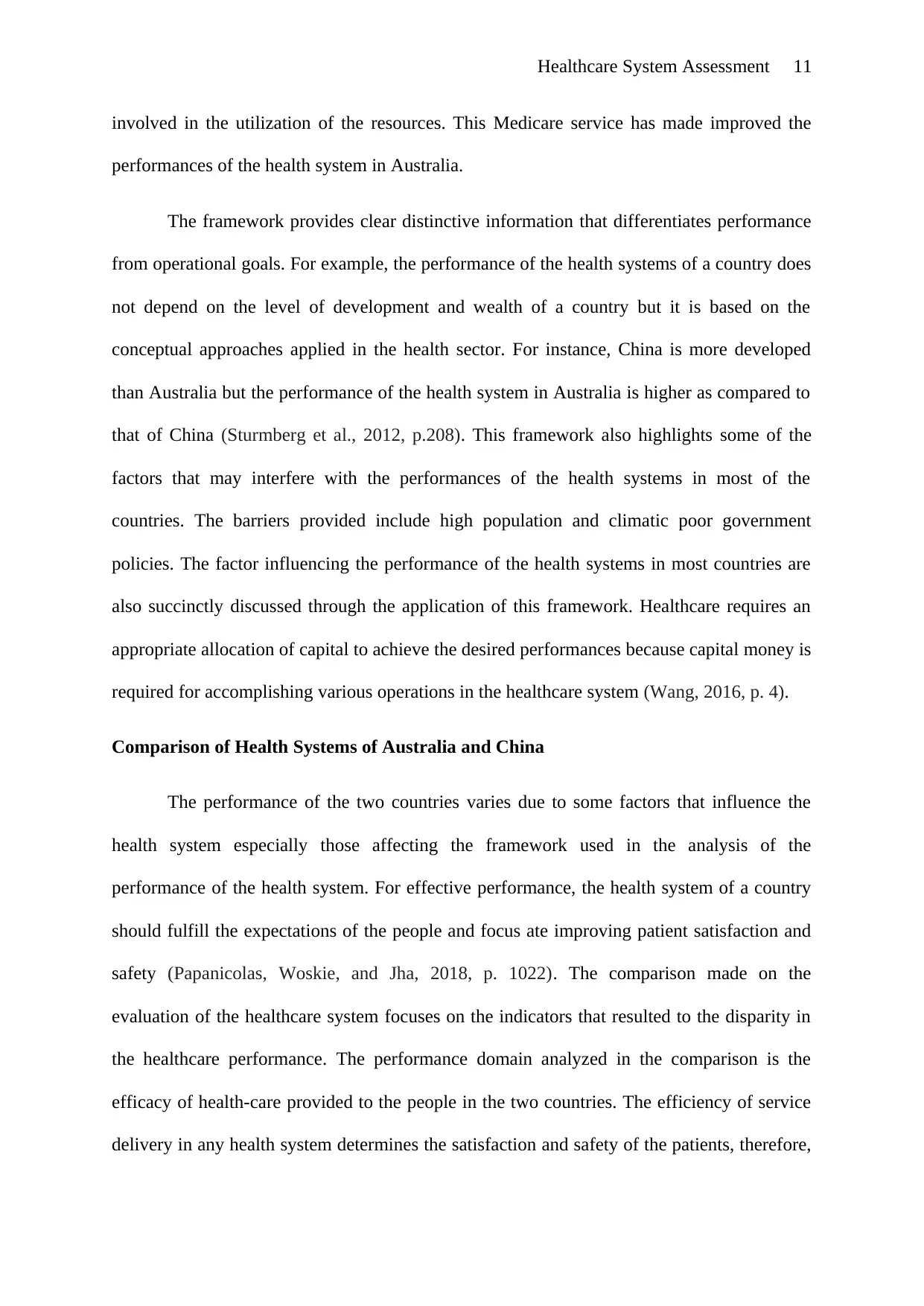
Healthcare System Assessment 11
involved in the utilization of the resources. This Medicare service has made improved the
performances of the health system in Australia.
The framework provides clear distinctive information that differentiates performance
from operational goals. For example, the performance of the health systems of a country does
not depend on the level of development and wealth of a country but it is based on the
conceptual approaches applied in the health sector. For instance, China is more developed
than Australia but the performance of the health system in Australia is higher as compared to
that of China (Sturmberg et al., 2012, p.208). This framework also highlights some of the
factors that may interfere with the performances of the health systems in most of the
countries. The barriers provided include high population and climatic poor government
policies. The factor influencing the performance of the health systems in most countries are
also succinctly discussed through the application of this framework. Healthcare requires an
appropriate allocation of capital to achieve the desired performances because capital money is
required for accomplishing various operations in the healthcare system (Wang, 2016, p. 4).
Comparison of Health Systems of Australia and China
The performance of the two countries varies due to some factors that influence the
health system especially those affecting the framework used in the analysis of the
performance of the health system. For effective performance, the health system of a country
should fulfill the expectations of the people and focus ate improving patient satisfaction and
safety (Papanicolas, Woskie, and Jha, 2018, p. 1022). The comparison made on the
evaluation of the healthcare system focuses on the indicators that resulted to the disparity in
the healthcare performance. The performance domain analyzed in the comparison is the
efficacy of health-care provided to the people in the two countries. The efficiency of service
delivery in any health system determines the satisfaction and safety of the patients, therefore,
involved in the utilization of the resources. This Medicare service has made improved the
performances of the health system in Australia.
The framework provides clear distinctive information that differentiates performance
from operational goals. For example, the performance of the health systems of a country does
not depend on the level of development and wealth of a country but it is based on the
conceptual approaches applied in the health sector. For instance, China is more developed
than Australia but the performance of the health system in Australia is higher as compared to
that of China (Sturmberg et al., 2012, p.208). This framework also highlights some of the
factors that may interfere with the performances of the health systems in most of the
countries. The barriers provided include high population and climatic poor government
policies. The factor influencing the performance of the health systems in most countries are
also succinctly discussed through the application of this framework. Healthcare requires an
appropriate allocation of capital to achieve the desired performances because capital money is
required for accomplishing various operations in the healthcare system (Wang, 2016, p. 4).
Comparison of Health Systems of Australia and China
The performance of the two countries varies due to some factors that influence the
health system especially those affecting the framework used in the analysis of the
performance of the health system. For effective performance, the health system of a country
should fulfill the expectations of the people and focus ate improving patient satisfaction and
safety (Papanicolas, Woskie, and Jha, 2018, p. 1022). The comparison made on the
evaluation of the healthcare system focuses on the indicators that resulted to the disparity in
the healthcare performance. The performance domain analyzed in the comparison is the
efficacy of health-care provided to the people in the two countries. The efficiency of service
delivery in any health system determines the satisfaction and safety of the patients, therefore,
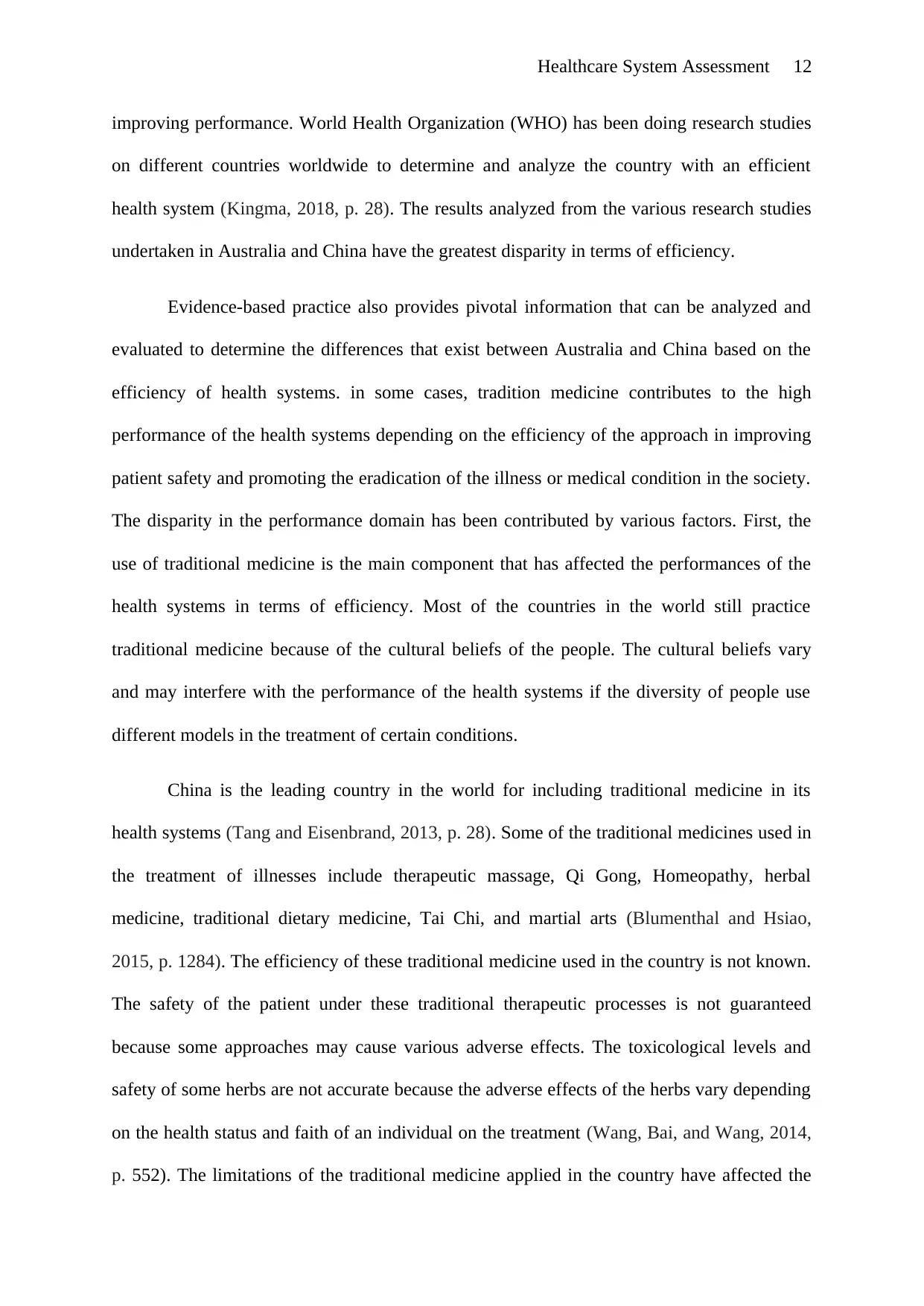
Healthcare System Assessment 12
improving performance. World Health Organization (WHO) has been doing research studies
on different countries worldwide to determine and analyze the country with an efficient
health system (Kingma, 2018, p. 28). The results analyzed from the various research studies
undertaken in Australia and China have the greatest disparity in terms of efficiency.
Evidence-based practice also provides pivotal information that can be analyzed and
evaluated to determine the differences that exist between Australia and China based on the
efficiency of health systems. in some cases, tradition medicine contributes to the high
performance of the health systems depending on the efficiency of the approach in improving
patient safety and promoting the eradication of the illness or medical condition in the society.
The disparity in the performance domain has been contributed by various factors. First, the
use of traditional medicine is the main component that has affected the performances of the
health systems in terms of efficiency. Most of the countries in the world still practice
traditional medicine because of the cultural beliefs of the people. The cultural beliefs vary
and may interfere with the performance of the health systems if the diversity of people use
different models in the treatment of certain conditions.
China is the leading country in the world for including traditional medicine in its
health systems (Tang and Eisenbrand, 2013, p. 28). Some of the traditional medicines used in
the treatment of illnesses include therapeutic massage, Qi Gong, Homeopathy, herbal
medicine, traditional dietary medicine, Tai Chi, and martial arts (Blumenthal and Hsiao,
2015, p. 1284). The efficiency of these traditional medicine used in the country is not known.
The safety of the patient under these traditional therapeutic processes is not guaranteed
because some approaches may cause various adverse effects. The toxicological levels and
safety of some herbs are not accurate because the adverse effects of the herbs vary depending
on the health status and faith of an individual on the treatment (Wang, Bai, and Wang, 2014,
p. 552). The limitations of the traditional medicine applied in the country have affected the
improving performance. World Health Organization (WHO) has been doing research studies
on different countries worldwide to determine and analyze the country with an efficient
health system (Kingma, 2018, p. 28). The results analyzed from the various research studies
undertaken in Australia and China have the greatest disparity in terms of efficiency.
Evidence-based practice also provides pivotal information that can be analyzed and
evaluated to determine the differences that exist between Australia and China based on the
efficiency of health systems. in some cases, tradition medicine contributes to the high
performance of the health systems depending on the efficiency of the approach in improving
patient safety and promoting the eradication of the illness or medical condition in the society.
The disparity in the performance domain has been contributed by various factors. First, the
use of traditional medicine is the main component that has affected the performances of the
health systems in terms of efficiency. Most of the countries in the world still practice
traditional medicine because of the cultural beliefs of the people. The cultural beliefs vary
and may interfere with the performance of the health systems if the diversity of people use
different models in the treatment of certain conditions.
China is the leading country in the world for including traditional medicine in its
health systems (Tang and Eisenbrand, 2013, p. 28). Some of the traditional medicines used in
the treatment of illnesses include therapeutic massage, Qi Gong, Homeopathy, herbal
medicine, traditional dietary medicine, Tai Chi, and martial arts (Blumenthal and Hsiao,
2015, p. 1284). The efficiency of these traditional medicine used in the country is not known.
The safety of the patient under these traditional therapeutic processes is not guaranteed
because some approaches may cause various adverse effects. The toxicological levels and
safety of some herbs are not accurate because the adverse effects of the herbs vary depending
on the health status and faith of an individual on the treatment (Wang, Bai, and Wang, 2014,
p. 552). The limitations of the traditional medicine applied in the country have affected the
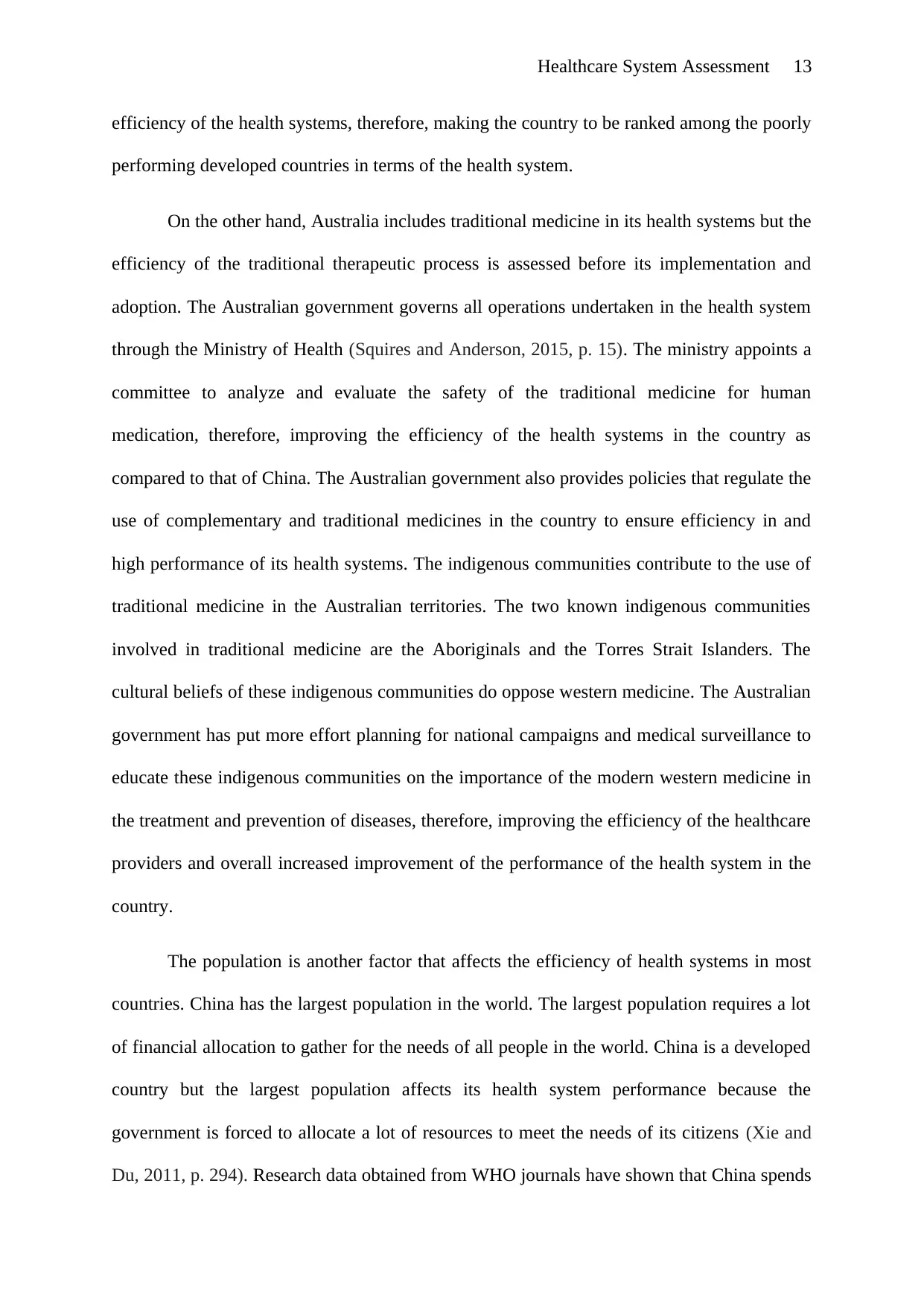
Healthcare System Assessment 13
efficiency of the health systems, therefore, making the country to be ranked among the poorly
performing developed countries in terms of the health system.
On the other hand, Australia includes traditional medicine in its health systems but the
efficiency of the traditional therapeutic process is assessed before its implementation and
adoption. The Australian government governs all operations undertaken in the health system
through the Ministry of Health (Squires and Anderson, 2015, p. 15). The ministry appoints a
committee to analyze and evaluate the safety of the traditional medicine for human
medication, therefore, improving the efficiency of the health systems in the country as
compared to that of China. The Australian government also provides policies that regulate the
use of complementary and traditional medicines in the country to ensure efficiency in and
high performance of its health systems. The indigenous communities contribute to the use of
traditional medicine in the Australian territories. The two known indigenous communities
involved in traditional medicine are the Aboriginals and the Torres Strait Islanders. The
cultural beliefs of these indigenous communities do oppose western medicine. The Australian
government has put more effort planning for national campaigns and medical surveillance to
educate these indigenous communities on the importance of the modern western medicine in
the treatment and prevention of diseases, therefore, improving the efficiency of the healthcare
providers and overall increased improvement of the performance of the health system in the
country.
The population is another factor that affects the efficiency of health systems in most
countries. China has the largest population in the world. The largest population requires a lot
of financial allocation to gather for the needs of all people in the world. China is a developed
country but the largest population affects its health system performance because the
government is forced to allocate a lot of resources to meet the needs of its citizens (Xie and
Du, 2011, p. 294). Research data obtained from WHO journals have shown that China spends
efficiency of the health systems, therefore, making the country to be ranked among the poorly
performing developed countries in terms of the health system.
On the other hand, Australia includes traditional medicine in its health systems but the
efficiency of the traditional therapeutic process is assessed before its implementation and
adoption. The Australian government governs all operations undertaken in the health system
through the Ministry of Health (Squires and Anderson, 2015, p. 15). The ministry appoints a
committee to analyze and evaluate the safety of the traditional medicine for human
medication, therefore, improving the efficiency of the health systems in the country as
compared to that of China. The Australian government also provides policies that regulate the
use of complementary and traditional medicines in the country to ensure efficiency in and
high performance of its health systems. The indigenous communities contribute to the use of
traditional medicine in the Australian territories. The two known indigenous communities
involved in traditional medicine are the Aboriginals and the Torres Strait Islanders. The
cultural beliefs of these indigenous communities do oppose western medicine. The Australian
government has put more effort planning for national campaigns and medical surveillance to
educate these indigenous communities on the importance of the modern western medicine in
the treatment and prevention of diseases, therefore, improving the efficiency of the healthcare
providers and overall increased improvement of the performance of the health system in the
country.
The population is another factor that affects the efficiency of health systems in most
countries. China has the largest population in the world. The largest population requires a lot
of financial allocation to gather for the needs of all people in the world. China is a developed
country but the largest population affects its health system performance because the
government is forced to allocate a lot of resources to meet the needs of its citizens (Xie and
Du, 2011, p. 294). Research data obtained from WHO journals have shown that China spends
Paraphrase This Document
Need a fresh take? Get an instant paraphrase of this document with our AI Paraphraser
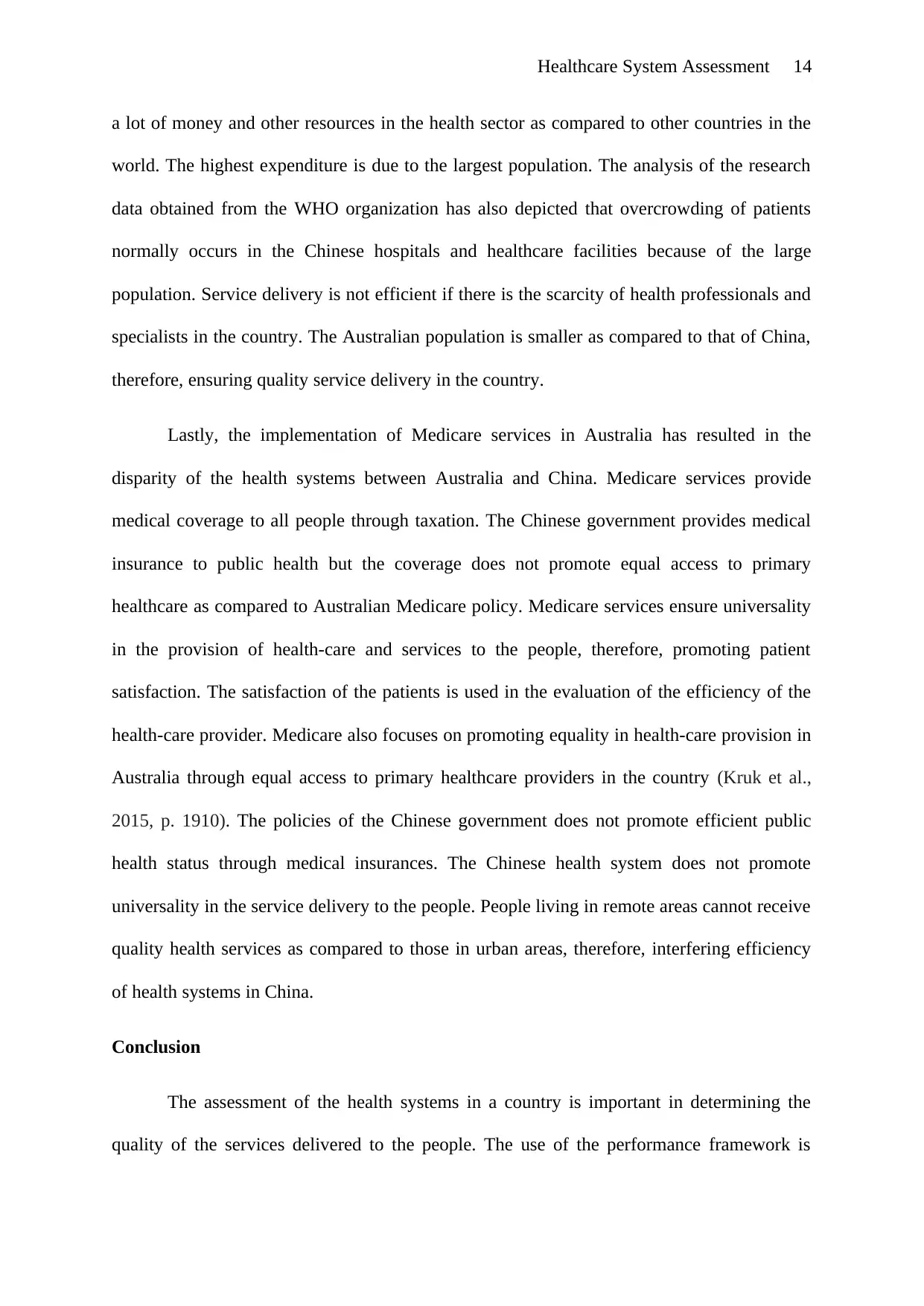
Healthcare System Assessment 14
a lot of money and other resources in the health sector as compared to other countries in the
world. The highest expenditure is due to the largest population. The analysis of the research
data obtained from the WHO organization has also depicted that overcrowding of patients
normally occurs in the Chinese hospitals and healthcare facilities because of the large
population. Service delivery is not efficient if there is the scarcity of health professionals and
specialists in the country. The Australian population is smaller as compared to that of China,
therefore, ensuring quality service delivery in the country.
Lastly, the implementation of Medicare services in Australia has resulted in the
disparity of the health systems between Australia and China. Medicare services provide
medical coverage to all people through taxation. The Chinese government provides medical
insurance to public health but the coverage does not promote equal access to primary
healthcare as compared to Australian Medicare policy. Medicare services ensure universality
in the provision of health-care and services to the people, therefore, promoting patient
satisfaction. The satisfaction of the patients is used in the evaluation of the efficiency of the
health-care provider. Medicare also focuses on promoting equality in health-care provision in
Australia through equal access to primary healthcare providers in the country (Kruk et al.,
2015, p. 1910). The policies of the Chinese government does not promote efficient public
health status through medical insurances. The Chinese health system does not promote
universality in the service delivery to the people. People living in remote areas cannot receive
quality health services as compared to those in urban areas, therefore, interfering efficiency
of health systems in China.
Conclusion
The assessment of the health systems in a country is important in determining the
quality of the services delivered to the people. The use of the performance framework is
a lot of money and other resources in the health sector as compared to other countries in the
world. The highest expenditure is due to the largest population. The analysis of the research
data obtained from the WHO organization has also depicted that overcrowding of patients
normally occurs in the Chinese hospitals and healthcare facilities because of the large
population. Service delivery is not efficient if there is the scarcity of health professionals and
specialists in the country. The Australian population is smaller as compared to that of China,
therefore, ensuring quality service delivery in the country.
Lastly, the implementation of Medicare services in Australia has resulted in the
disparity of the health systems between Australia and China. Medicare services provide
medical coverage to all people through taxation. The Chinese government provides medical
insurance to public health but the coverage does not promote equal access to primary
healthcare as compared to Australian Medicare policy. Medicare services ensure universality
in the provision of health-care and services to the people, therefore, promoting patient
satisfaction. The satisfaction of the patients is used in the evaluation of the efficiency of the
health-care provider. Medicare also focuses on promoting equality in health-care provision in
Australia through equal access to primary healthcare providers in the country (Kruk et al.,
2015, p. 1910). The policies of the Chinese government does not promote efficient public
health status through medical insurances. The Chinese health system does not promote
universality in the service delivery to the people. People living in remote areas cannot receive
quality health services as compared to those in urban areas, therefore, interfering efficiency
of health systems in China.
Conclusion
The assessment of the health systems in a country is important in determining the
quality of the services delivered to the people. The use of the performance framework is
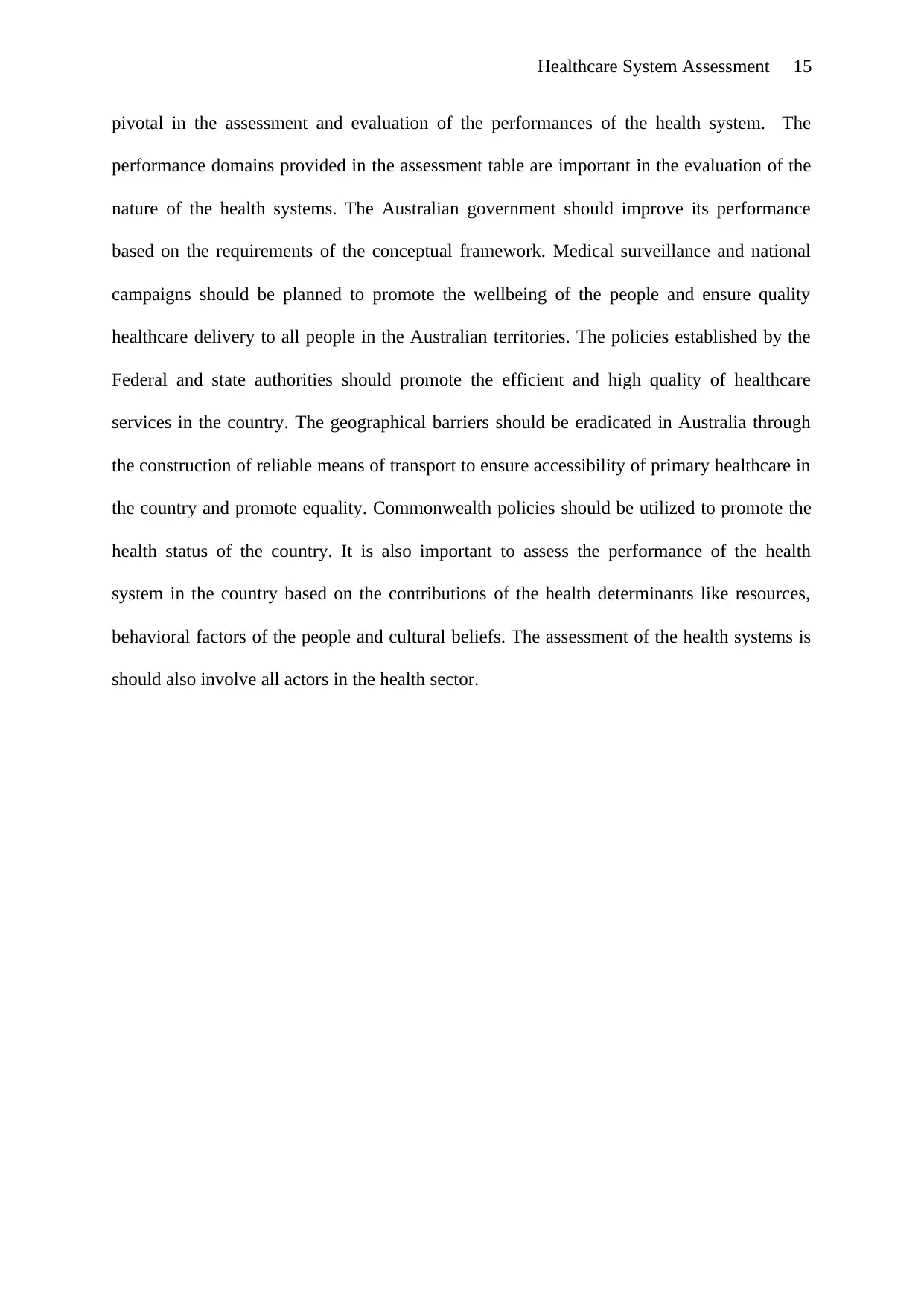
Healthcare System Assessment 15
pivotal in the assessment and evaluation of the performances of the health system. The
performance domains provided in the assessment table are important in the evaluation of the
nature of the health systems. The Australian government should improve its performance
based on the requirements of the conceptual framework. Medical surveillance and national
campaigns should be planned to promote the wellbeing of the people and ensure quality
healthcare delivery to all people in the Australian territories. The policies established by the
Federal and state authorities should promote the efficient and high quality of healthcare
services in the country. The geographical barriers should be eradicated in Australia through
the construction of reliable means of transport to ensure accessibility of primary healthcare in
the country and promote equality. Commonwealth policies should be utilized to promote the
health status of the country. It is also important to assess the performance of the health
system in the country based on the contributions of the health determinants like resources,
behavioral factors of the people and cultural beliefs. The assessment of the health systems is
should also involve all actors in the health sector.
pivotal in the assessment and evaluation of the performances of the health system. The
performance domains provided in the assessment table are important in the evaluation of the
nature of the health systems. The Australian government should improve its performance
based on the requirements of the conceptual framework. Medical surveillance and national
campaigns should be planned to promote the wellbeing of the people and ensure quality
healthcare delivery to all people in the Australian territories. The policies established by the
Federal and state authorities should promote the efficient and high quality of healthcare
services in the country. The geographical barriers should be eradicated in Australia through
the construction of reliable means of transport to ensure accessibility of primary healthcare in
the country and promote equality. Commonwealth policies should be utilized to promote the
health status of the country. It is also important to assess the performance of the health
system in the country based on the contributions of the health determinants like resources,
behavioral factors of the people and cultural beliefs. The assessment of the health systems is
should also involve all actors in the health sector.
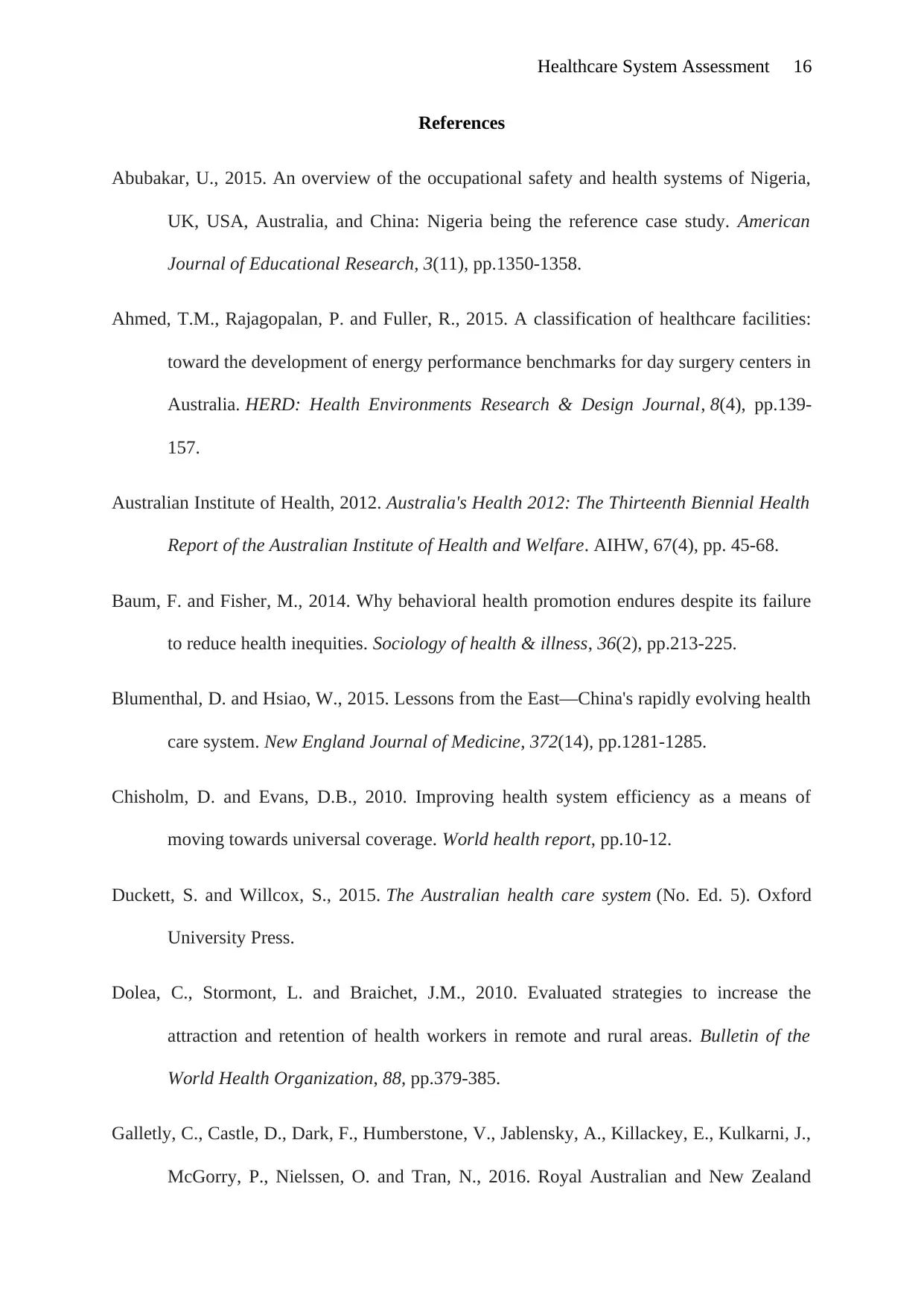
Healthcare System Assessment 16
References
Abubakar, U., 2015. An overview of the occupational safety and health systems of Nigeria,
UK, USA, Australia, and China: Nigeria being the reference case study. American
Journal of Educational Research, 3(11), pp.1350-1358.
Ahmed, T.M., Rajagopalan, P. and Fuller, R., 2015. A classification of healthcare facilities:
toward the development of energy performance benchmarks for day surgery centers in
Australia. HERD: Health Environments Research & Design Journal, 8(4), pp.139-
157.
Australian Institute of Health, 2012. Australia's Health 2012: The Thirteenth Biennial Health
Report of the Australian Institute of Health and Welfare. AIHW, 67(4), pp. 45-68.
Baum, F. and Fisher, M., 2014. Why behavioral health promotion endures despite its failure
to reduce health inequities. Sociology of health & illness, 36(2), pp.213-225.
Blumenthal, D. and Hsiao, W., 2015. Lessons from the East—China's rapidly evolving health
care system. New England Journal of Medicine, 372(14), pp.1281-1285.
Chisholm, D. and Evans, D.B., 2010. Improving health system efficiency as a means of
moving towards universal coverage. World health report, pp.10-12.
Duckett, S. and Willcox, S., 2015. The Australian health care system (No. Ed. 5). Oxford
University Press.
Dolea, C., Stormont, L. and Braichet, J.M., 2010. Evaluated strategies to increase the
attraction and retention of health workers in remote and rural areas. Bulletin of the
World Health Organization, 88, pp.379-385.
Galletly, C., Castle, D., Dark, F., Humberstone, V., Jablensky, A., Killackey, E., Kulkarni, J.,
McGorry, P., Nielssen, O. and Tran, N., 2016. Royal Australian and New Zealand
References
Abubakar, U., 2015. An overview of the occupational safety and health systems of Nigeria,
UK, USA, Australia, and China: Nigeria being the reference case study. American
Journal of Educational Research, 3(11), pp.1350-1358.
Ahmed, T.M., Rajagopalan, P. and Fuller, R., 2015. A classification of healthcare facilities:
toward the development of energy performance benchmarks for day surgery centers in
Australia. HERD: Health Environments Research & Design Journal, 8(4), pp.139-
157.
Australian Institute of Health, 2012. Australia's Health 2012: The Thirteenth Biennial Health
Report of the Australian Institute of Health and Welfare. AIHW, 67(4), pp. 45-68.
Baum, F. and Fisher, M., 2014. Why behavioral health promotion endures despite its failure
to reduce health inequities. Sociology of health & illness, 36(2), pp.213-225.
Blumenthal, D. and Hsiao, W., 2015. Lessons from the East—China's rapidly evolving health
care system. New England Journal of Medicine, 372(14), pp.1281-1285.
Chisholm, D. and Evans, D.B., 2010. Improving health system efficiency as a means of
moving towards universal coverage. World health report, pp.10-12.
Duckett, S. and Willcox, S., 2015. The Australian health care system (No. Ed. 5). Oxford
University Press.
Dolea, C., Stormont, L. and Braichet, J.M., 2010. Evaluated strategies to increase the
attraction and retention of health workers in remote and rural areas. Bulletin of the
World Health Organization, 88, pp.379-385.
Galletly, C., Castle, D., Dark, F., Humberstone, V., Jablensky, A., Killackey, E., Kulkarni, J.,
McGorry, P., Nielssen, O. and Tran, N., 2016. Royal Australian and New Zealand
Secure Best Marks with AI Grader
Need help grading? Try our AI Grader for instant feedback on your assignments.
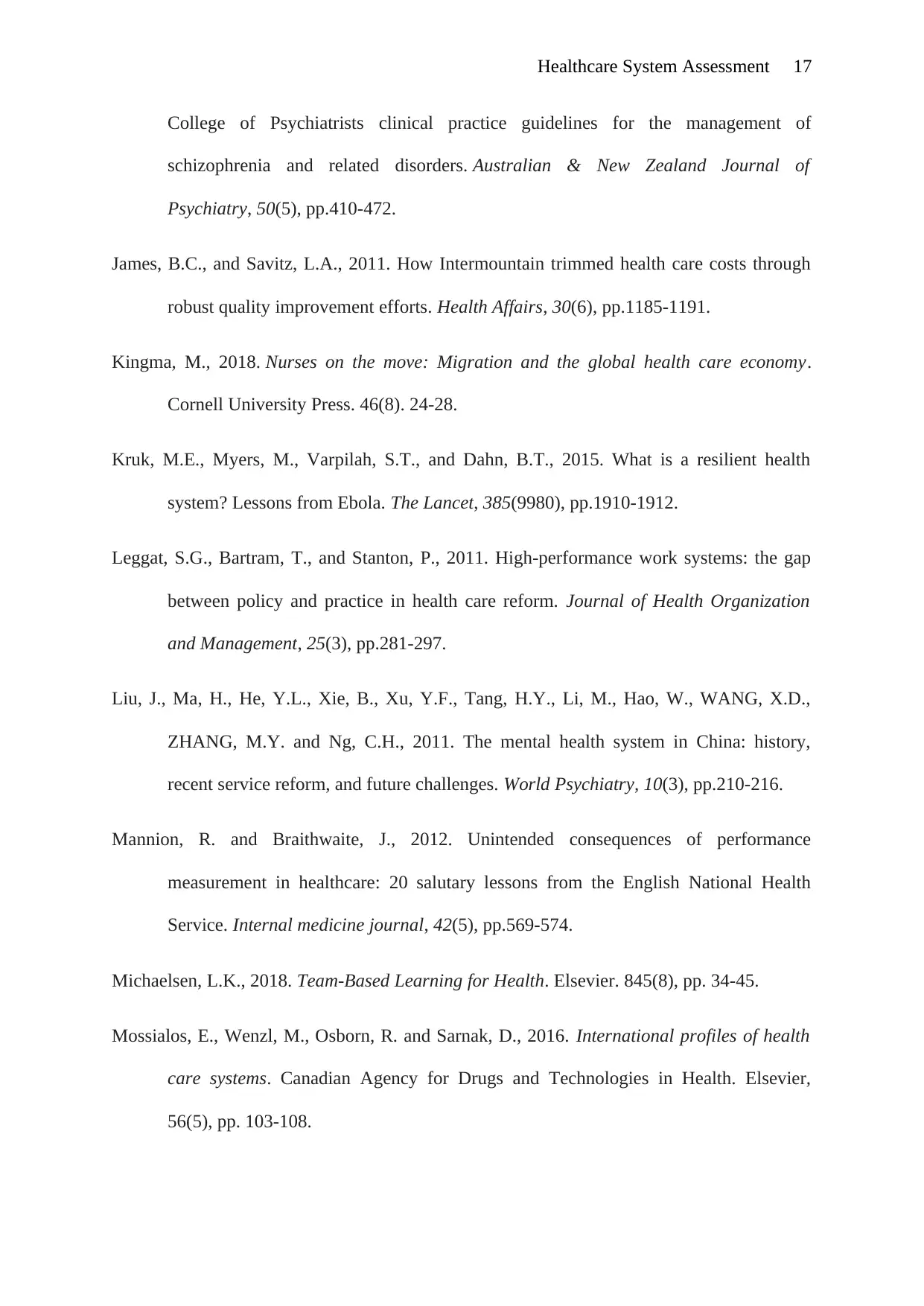
Healthcare System Assessment 17
College of Psychiatrists clinical practice guidelines for the management of
schizophrenia and related disorders. Australian & New Zealand Journal of
Psychiatry, 50(5), pp.410-472.
James, B.C., and Savitz, L.A., 2011. How Intermountain trimmed health care costs through
robust quality improvement efforts. Health Affairs, 30(6), pp.1185-1191.
Kingma, M., 2018. Nurses on the move: Migration and the global health care economy.
Cornell University Press. 46(8). 24-28.
Kruk, M.E., Myers, M., Varpilah, S.T., and Dahn, B.T., 2015. What is a resilient health
system? Lessons from Ebola. The Lancet, 385(9980), pp.1910-1912.
Leggat, S.G., Bartram, T., and Stanton, P., 2011. High-performance work systems: the gap
between policy and practice in health care reform. Journal of Health Organization
and Management, 25(3), pp.281-297.
Liu, J., Ma, H., He, Y.L., Xie, B., Xu, Y.F., Tang, H.Y., Li, M., Hao, W., WANG, X.D.,
ZHANG, M.Y. and Ng, C.H., 2011. The mental health system in China: history,
recent service reform, and future challenges. World Psychiatry, 10(3), pp.210-216.
Mannion, R. and Braithwaite, J., 2012. Unintended consequences of performance
measurement in healthcare: 20 salutary lessons from the English National Health
Service. Internal medicine journal, 42(5), pp.569-574.
Michaelsen, L.K., 2018. Team-Based Learning for Health. Elsevier. 845(8), pp. 34-45.
Mossialos, E., Wenzl, M., Osborn, R. and Sarnak, D., 2016. International profiles of health
care systems. Canadian Agency for Drugs and Technologies in Health. Elsevier,
56(5), pp. 103-108.
College of Psychiatrists clinical practice guidelines for the management of
schizophrenia and related disorders. Australian & New Zealand Journal of
Psychiatry, 50(5), pp.410-472.
James, B.C., and Savitz, L.A., 2011. How Intermountain trimmed health care costs through
robust quality improvement efforts. Health Affairs, 30(6), pp.1185-1191.
Kingma, M., 2018. Nurses on the move: Migration and the global health care economy.
Cornell University Press. 46(8). 24-28.
Kruk, M.E., Myers, M., Varpilah, S.T., and Dahn, B.T., 2015. What is a resilient health
system? Lessons from Ebola. The Lancet, 385(9980), pp.1910-1912.
Leggat, S.G., Bartram, T., and Stanton, P., 2011. High-performance work systems: the gap
between policy and practice in health care reform. Journal of Health Organization
and Management, 25(3), pp.281-297.
Liu, J., Ma, H., He, Y.L., Xie, B., Xu, Y.F., Tang, H.Y., Li, M., Hao, W., WANG, X.D.,
ZHANG, M.Y. and Ng, C.H., 2011. The mental health system in China: history,
recent service reform, and future challenges. World Psychiatry, 10(3), pp.210-216.
Mannion, R. and Braithwaite, J., 2012. Unintended consequences of performance
measurement in healthcare: 20 salutary lessons from the English National Health
Service. Internal medicine journal, 42(5), pp.569-574.
Michaelsen, L.K., 2018. Team-Based Learning for Health. Elsevier. 845(8), pp. 34-45.
Mossialos, E., Wenzl, M., Osborn, R. and Sarnak, D., 2016. International profiles of health
care systems. Canadian Agency for Drugs and Technologies in Health. Elsevier,
56(5), pp. 103-108.
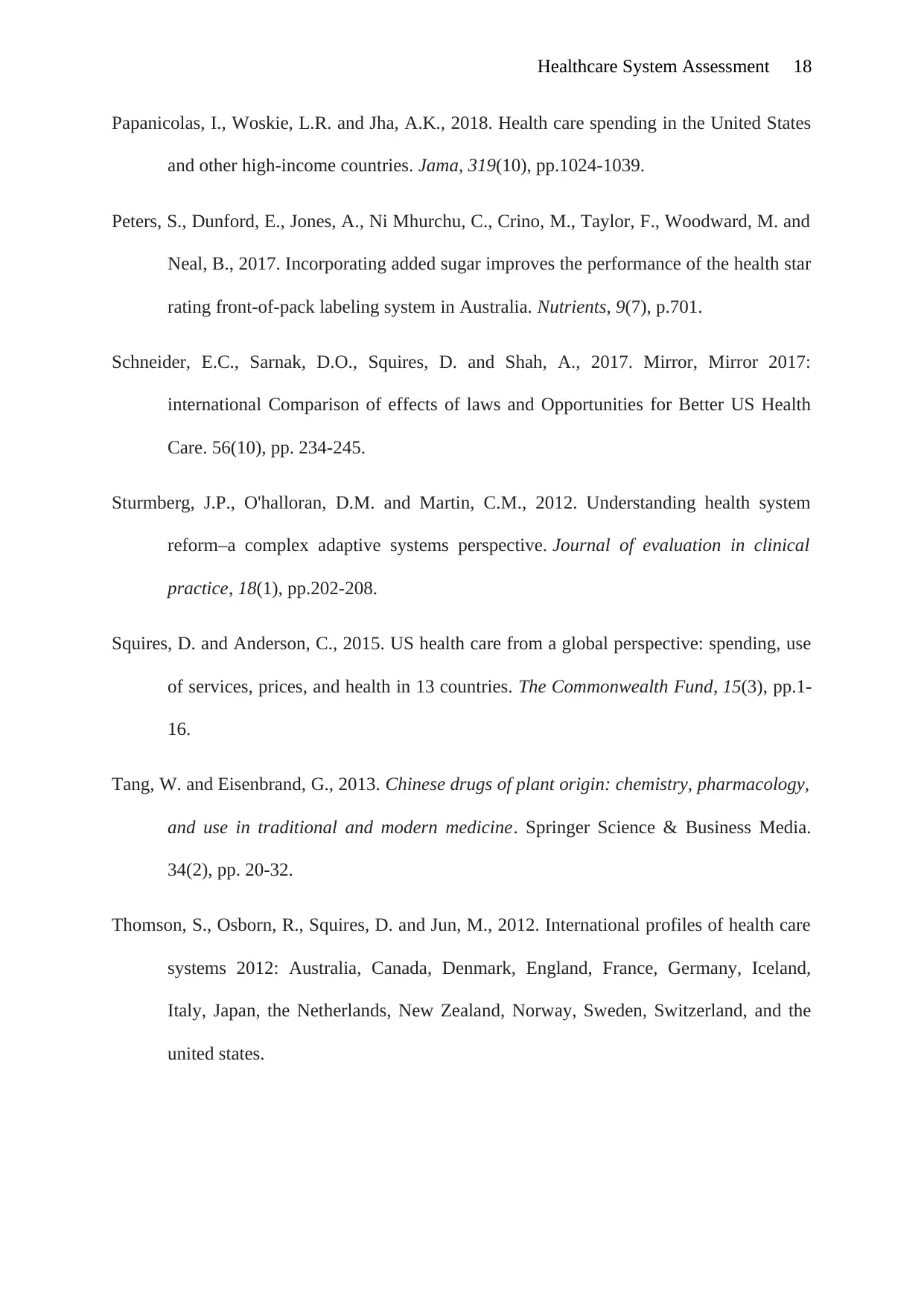
Healthcare System Assessment 18
Papanicolas, I., Woskie, L.R. and Jha, A.K., 2018. Health care spending in the United States
and other high-income countries. Jama, 319(10), pp.1024-1039.
Peters, S., Dunford, E., Jones, A., Ni Mhurchu, C., Crino, M., Taylor, F., Woodward, M. and
Neal, B., 2017. Incorporating added sugar improves the performance of the health star
rating front-of-pack labeling system in Australia. Nutrients, 9(7), p.701.
Schneider, E.C., Sarnak, D.O., Squires, D. and Shah, A., 2017. Mirror, Mirror 2017:
international Comparison of effects of laws and Opportunities for Better US Health
Care. 56(10), pp. 234-245.
Sturmberg, J.P., O'halloran, D.M. and Martin, C.M., 2012. Understanding health system
reform–a complex adaptive systems perspective. Journal of evaluation in clinical
practice, 18(1), pp.202-208.
Squires, D. and Anderson, C., 2015. US health care from a global perspective: spending, use
of services, prices, and health in 13 countries. The Commonwealth Fund, 15(3), pp.1-
16.
Tang, W. and Eisenbrand, G., 2013. Chinese drugs of plant origin: chemistry, pharmacology,
and use in traditional and modern medicine. Springer Science & Business Media.
34(2), pp. 20-32.
Thomson, S., Osborn, R., Squires, D. and Jun, M., 2012. International profiles of health care
systems 2012: Australia, Canada, Denmark, England, France, Germany, Iceland,
Italy, Japan, the Netherlands, New Zealand, Norway, Sweden, Switzerland, and the
united states.
Papanicolas, I., Woskie, L.R. and Jha, A.K., 2018. Health care spending in the United States
and other high-income countries. Jama, 319(10), pp.1024-1039.
Peters, S., Dunford, E., Jones, A., Ni Mhurchu, C., Crino, M., Taylor, F., Woodward, M. and
Neal, B., 2017. Incorporating added sugar improves the performance of the health star
rating front-of-pack labeling system in Australia. Nutrients, 9(7), p.701.
Schneider, E.C., Sarnak, D.O., Squires, D. and Shah, A., 2017. Mirror, Mirror 2017:
international Comparison of effects of laws and Opportunities for Better US Health
Care. 56(10), pp. 234-245.
Sturmberg, J.P., O'halloran, D.M. and Martin, C.M., 2012. Understanding health system
reform–a complex adaptive systems perspective. Journal of evaluation in clinical
practice, 18(1), pp.202-208.
Squires, D. and Anderson, C., 2015. US health care from a global perspective: spending, use
of services, prices, and health in 13 countries. The Commonwealth Fund, 15(3), pp.1-
16.
Tang, W. and Eisenbrand, G., 2013. Chinese drugs of plant origin: chemistry, pharmacology,
and use in traditional and modern medicine. Springer Science & Business Media.
34(2), pp. 20-32.
Thomson, S., Osborn, R., Squires, D. and Jun, M., 2012. International profiles of health care
systems 2012: Australia, Canada, Denmark, England, France, Germany, Iceland,
Italy, Japan, the Netherlands, New Zealand, Norway, Sweden, Switzerland, and the
united states.
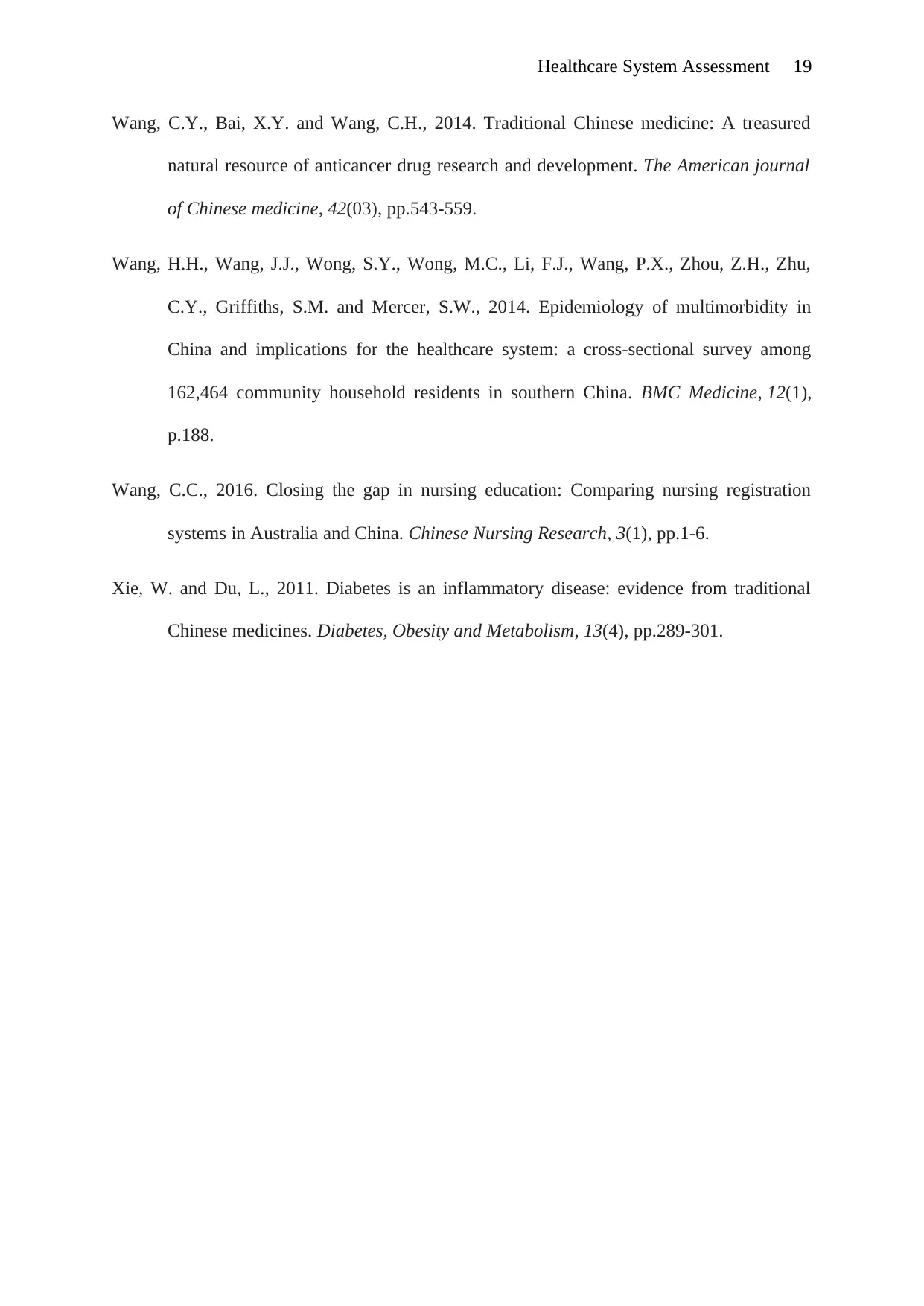
Healthcare System Assessment 19
Wang, C.Y., Bai, X.Y. and Wang, C.H., 2014. Traditional Chinese medicine: A treasured
natural resource of anticancer drug research and development. The American journal
of Chinese medicine, 42(03), pp.543-559.
Wang, H.H., Wang, J.J., Wong, S.Y., Wong, M.C., Li, F.J., Wang, P.X., Zhou, Z.H., Zhu,
C.Y., Griffiths, S.M. and Mercer, S.W., 2014. Epidemiology of multimorbidity in
China and implications for the healthcare system: a cross-sectional survey among
162,464 community household residents in southern China. BMC Medicine, 12(1),
p.188.
Wang, C.C., 2016. Closing the gap in nursing education: Comparing nursing registration
systems in Australia and China. Chinese Nursing Research, 3(1), pp.1-6.
Xie, W. and Du, L., 2011. Diabetes is an inflammatory disease: evidence from traditional
Chinese medicines. Diabetes, Obesity and Metabolism, 13(4), pp.289-301.
Wang, C.Y., Bai, X.Y. and Wang, C.H., 2014. Traditional Chinese medicine: A treasured
natural resource of anticancer drug research and development. The American journal
of Chinese medicine, 42(03), pp.543-559.
Wang, H.H., Wang, J.J., Wong, S.Y., Wong, M.C., Li, F.J., Wang, P.X., Zhou, Z.H., Zhu,
C.Y., Griffiths, S.M. and Mercer, S.W., 2014. Epidemiology of multimorbidity in
China and implications for the healthcare system: a cross-sectional survey among
162,464 community household residents in southern China. BMC Medicine, 12(1),
p.188.
Wang, C.C., 2016. Closing the gap in nursing education: Comparing nursing registration
systems in Australia and China. Chinese Nursing Research, 3(1), pp.1-6.
Xie, W. and Du, L., 2011. Diabetes is an inflammatory disease: evidence from traditional
Chinese medicines. Diabetes, Obesity and Metabolism, 13(4), pp.289-301.
1 out of 19
Related Documents
Your All-in-One AI-Powered Toolkit for Academic Success.
+13062052269
info@desklib.com
Available 24*7 on WhatsApp / Email
![[object Object]](/_next/static/media/star-bottom.7253800d.svg)
Unlock your academic potential
© 2024 | Zucol Services PVT LTD | All rights reserved.





